Examining Manipulative Advertising Through Ethical Frameworks
VerifiedAdded on 2023/06/13
|23
|5445
|330
Essay
AI Summary
This essay critically examines the ethical question of whether advertising companies should be allowed to use manipulative advertising techniques. It begins by providing a background discussion on the importance of this issue, highlighting how manipulative advertisements can negatively impact consumers by inducing unnecessary purchases and increasing debt. The analysis incorporates relevant facts, such as the use of actors as experts, the exploitation of attractiveness associations, and the rise of food advertising contributing to obesity. Assumptions made by advertising agencies are identified, including the belief that such practices are legal and contribute to organizational profits. Act utilitarianism is applied to evaluate the ethical question, weighing the positive consequences for companies against the negative consequences for consumers. The essay concludes that manipulative advertisements are unethical because they harm the majority (consumers) for the benefit of a minority (advertising agencies and product sellers), failing to promote the greatest good for the greatest number. The second part of the essay further analyzes the ethical question through the lens of virtue ethics, focusing on the virtues of honesty, justice, and accountability, and applies Kant's categorical imperative to assess the morality of manipulative advertising.
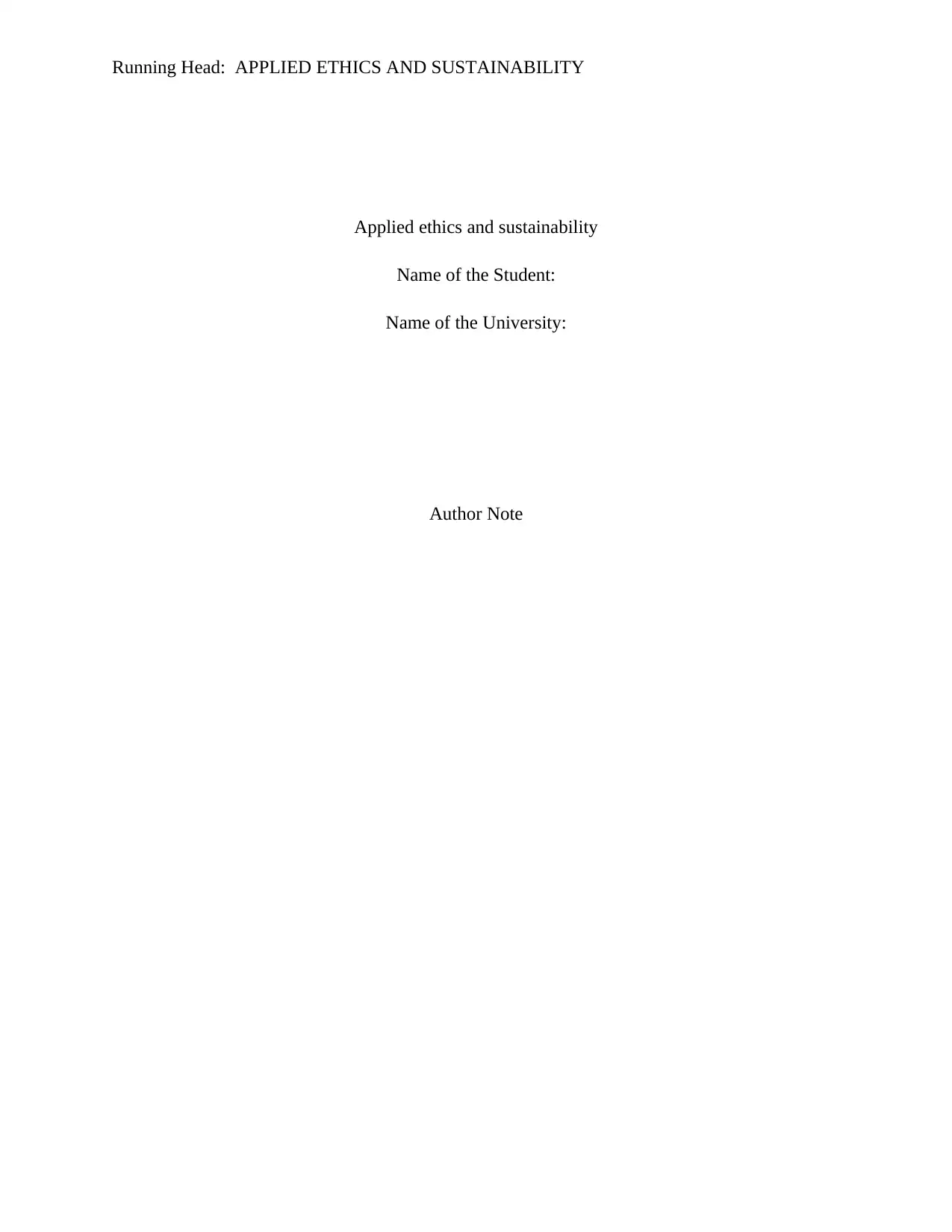
Running Head: APPLIED ETHICS AND SUSTAINABILITY
Applied ethics and sustainability
Name of the Student:
Name of the University:
Author Note
Applied ethics and sustainability
Name of the Student:
Name of the University:
Author Note
Secure Best Marks with AI Grader
Need help grading? Try our AI Grader for instant feedback on your assignments.
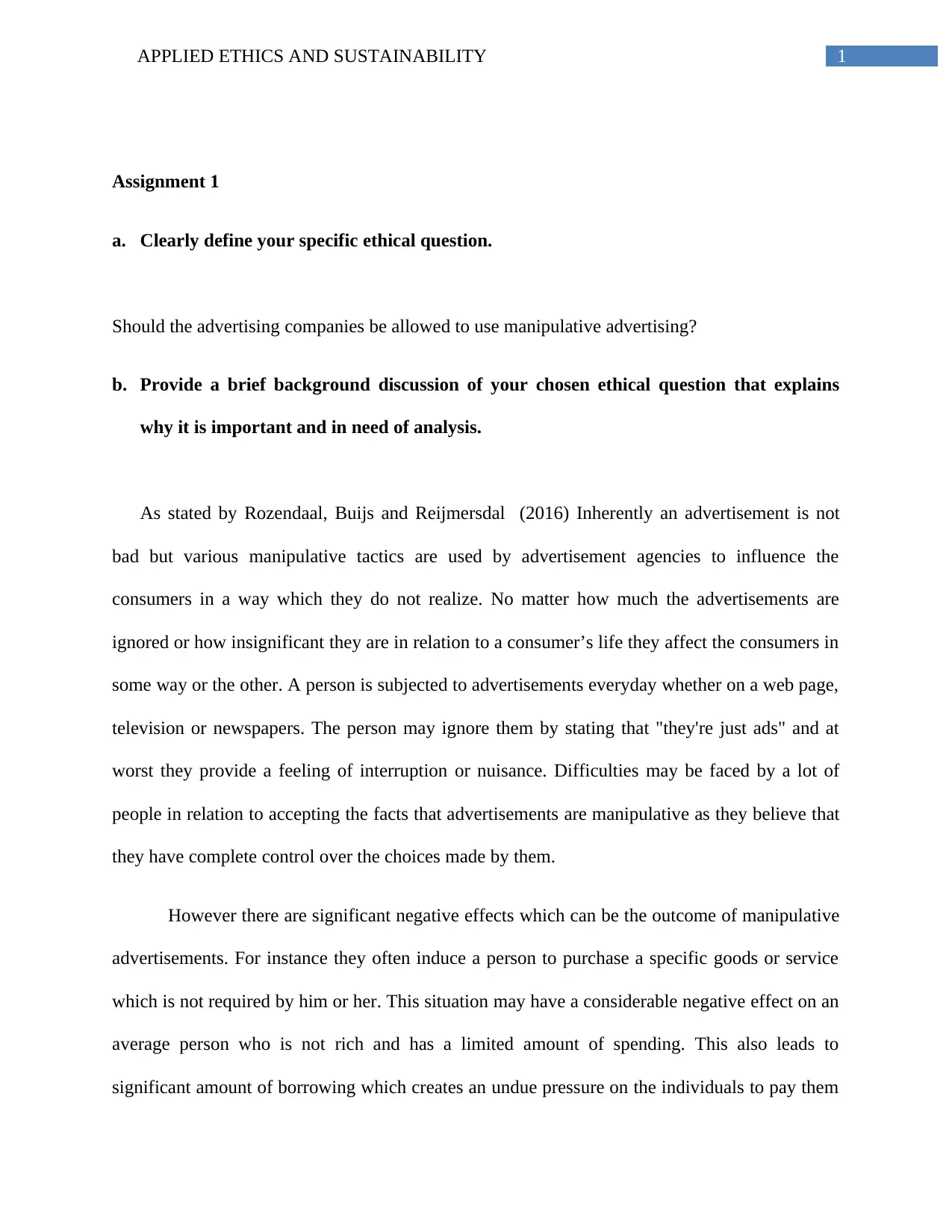
1APPLIED ETHICS AND SUSTAINABILITY
Assignment 1
a. Clearly define your specific ethical question.
Should the advertising companies be allowed to use manipulative advertising?
b. Provide a brief background discussion of your chosen ethical question that explains
why it is important and in need of analysis.
As stated by Rozendaal, Buijs and Reijmersdal (2016) Inherently an advertisement is not
bad but various manipulative tactics are used by advertisement agencies to influence the
consumers in a way which they do not realize. No matter how much the advertisements are
ignored or how insignificant they are in relation to a consumer’s life they affect the consumers in
some way or the other. A person is subjected to advertisements everyday whether on a web page,
television or newspapers. The person may ignore them by stating that "they're just ads" and at
worst they provide a feeling of interruption or nuisance. Difficulties may be faced by a lot of
people in relation to accepting the facts that advertisements are manipulative as they believe that
they have complete control over the choices made by them.
However there are significant negative effects which can be the outcome of manipulative
advertisements. For instance they often induce a person to purchase a specific goods or service
which is not required by him or her. This situation may have a considerable negative effect on an
average person who is not rich and has a limited amount of spending. This also leads to
significant amount of borrowing which creates an undue pressure on the individuals to pay them
Assignment 1
a. Clearly define your specific ethical question.
Should the advertising companies be allowed to use manipulative advertising?
b. Provide a brief background discussion of your chosen ethical question that explains
why it is important and in need of analysis.
As stated by Rozendaal, Buijs and Reijmersdal (2016) Inherently an advertisement is not
bad but various manipulative tactics are used by advertisement agencies to influence the
consumers in a way which they do not realize. No matter how much the advertisements are
ignored or how insignificant they are in relation to a consumer’s life they affect the consumers in
some way or the other. A person is subjected to advertisements everyday whether on a web page,
television or newspapers. The person may ignore them by stating that "they're just ads" and at
worst they provide a feeling of interruption or nuisance. Difficulties may be faced by a lot of
people in relation to accepting the facts that advertisements are manipulative as they believe that
they have complete control over the choices made by them.
However there are significant negative effects which can be the outcome of manipulative
advertisements. For instance they often induce a person to purchase a specific goods or service
which is not required by him or her. This situation may have a considerable negative effect on an
average person who is not rich and has a limited amount of spending. This also leads to
significant amount of borrowing which creates an undue pressure on the individuals to pay them
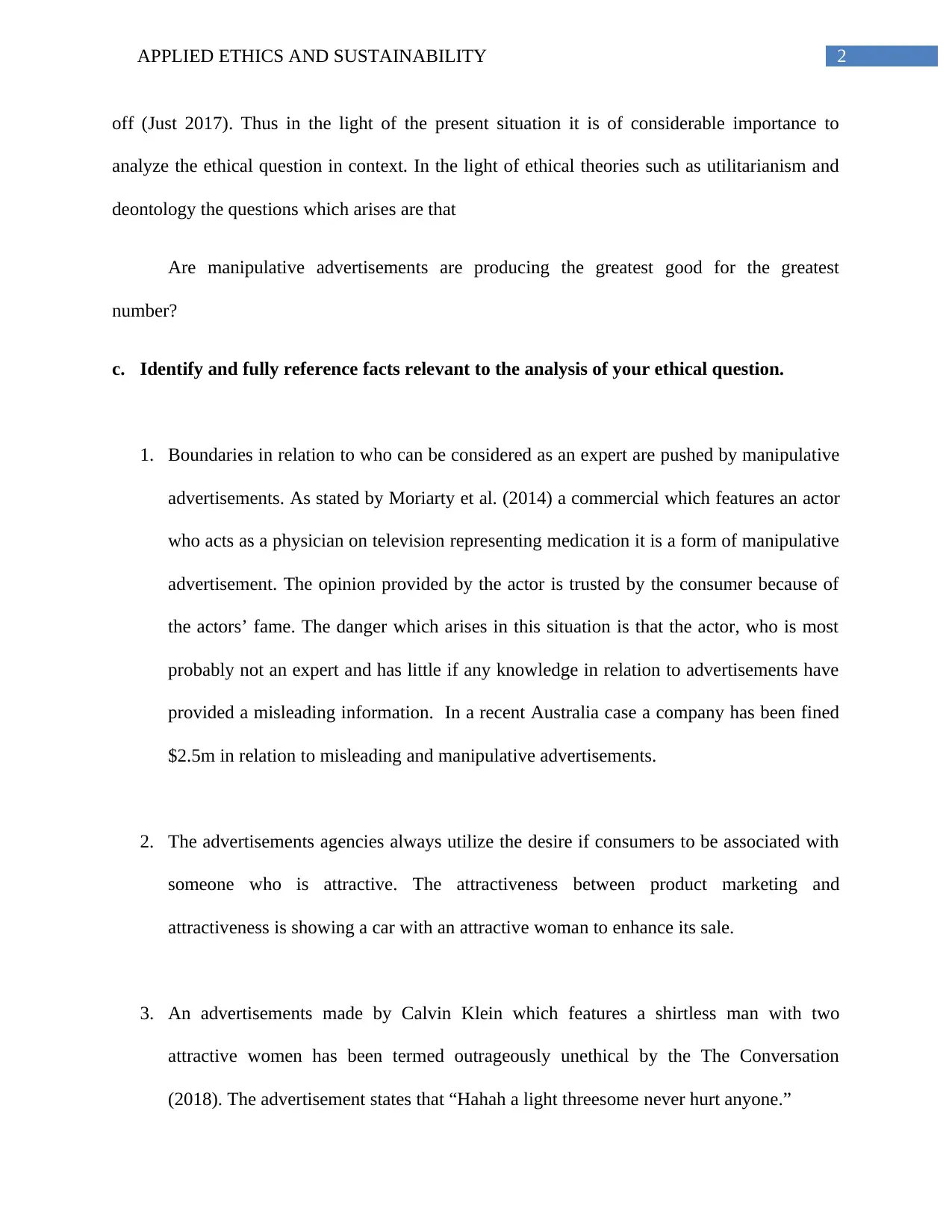
2APPLIED ETHICS AND SUSTAINABILITY
off (Just 2017). Thus in the light of the present situation it is of considerable importance to
analyze the ethical question in context. In the light of ethical theories such as utilitarianism and
deontology the questions which arises are that
Are manipulative advertisements are producing the greatest good for the greatest
number?
c. Identify and fully reference facts relevant to the analysis of your ethical question.
1. Boundaries in relation to who can be considered as an expert are pushed by manipulative
advertisements. As stated by Moriarty et al. (2014) a commercial which features an actor
who acts as a physician on television representing medication it is a form of manipulative
advertisement. The opinion provided by the actor is trusted by the consumer because of
the actors’ fame. The danger which arises in this situation is that the actor, who is most
probably not an expert and has little if any knowledge in relation to advertisements have
provided a misleading information. In a recent Australia case a company has been fined
$2.5m in relation to misleading and manipulative advertisements.
2. The advertisements agencies always utilize the desire if consumers to be associated with
someone who is attractive. The attractiveness between product marketing and
attractiveness is showing a car with an attractive woman to enhance its sale.
3. An advertisements made by Calvin Klein which features a shirtless man with two
attractive women has been termed outrageously unethical by the The Conversation
(2018). The advertisement states that “Hahah a light threesome never hurt anyone.”
off (Just 2017). Thus in the light of the present situation it is of considerable importance to
analyze the ethical question in context. In the light of ethical theories such as utilitarianism and
deontology the questions which arises are that
Are manipulative advertisements are producing the greatest good for the greatest
number?
c. Identify and fully reference facts relevant to the analysis of your ethical question.
1. Boundaries in relation to who can be considered as an expert are pushed by manipulative
advertisements. As stated by Moriarty et al. (2014) a commercial which features an actor
who acts as a physician on television representing medication it is a form of manipulative
advertisement. The opinion provided by the actor is trusted by the consumer because of
the actors’ fame. The danger which arises in this situation is that the actor, who is most
probably not an expert and has little if any knowledge in relation to advertisements have
provided a misleading information. In a recent Australia case a company has been fined
$2.5m in relation to misleading and manipulative advertisements.
2. The advertisements agencies always utilize the desire if consumers to be associated with
someone who is attractive. The attractiveness between product marketing and
attractiveness is showing a car with an attractive woman to enhance its sale.
3. An advertisements made by Calvin Klein which features a shirtless man with two
attractive women has been termed outrageously unethical by the The Conversation
(2018). The advertisement states that “Hahah a light threesome never hurt anyone.”
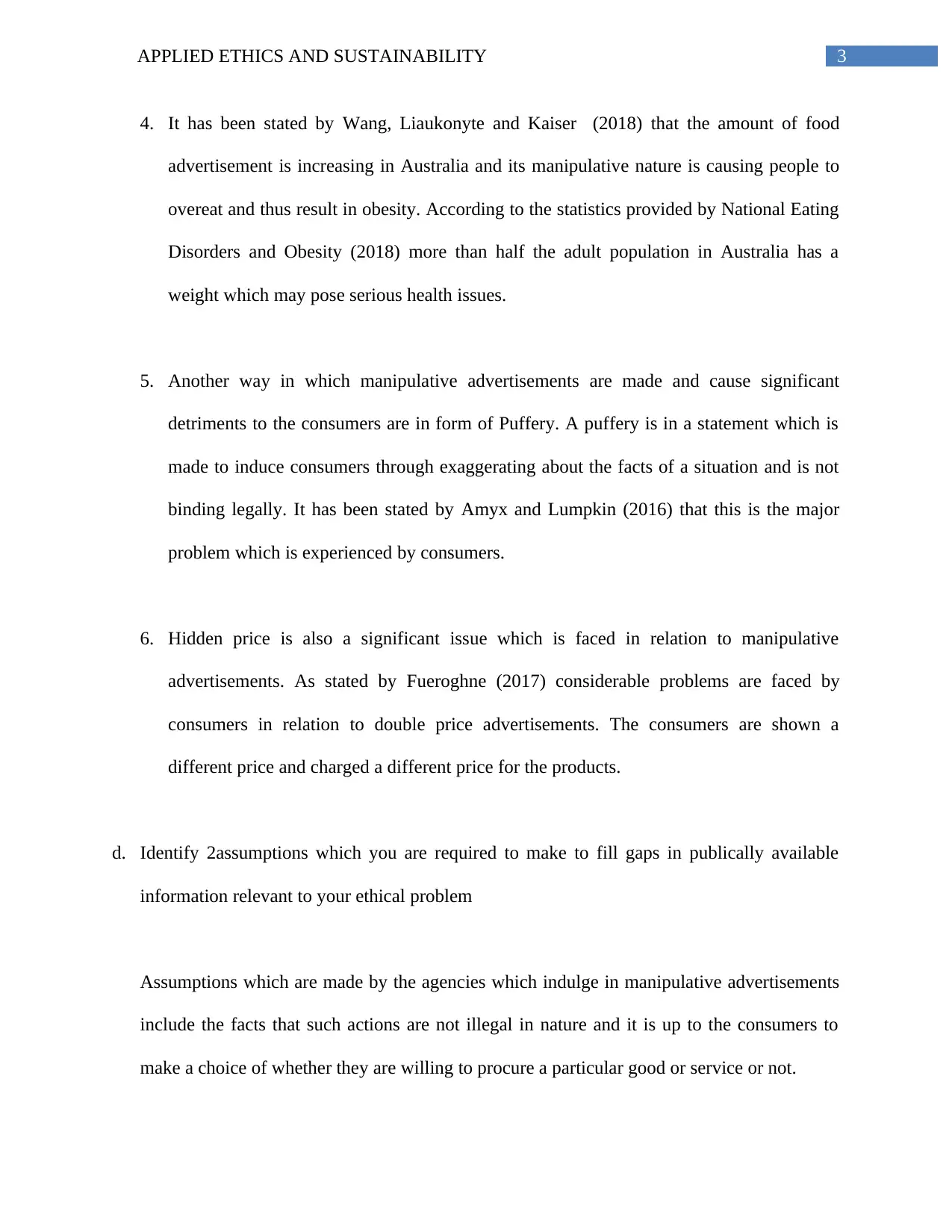
3APPLIED ETHICS AND SUSTAINABILITY
4. It has been stated by Wang, Liaukonyte and Kaiser (2018) that the amount of food
advertisement is increasing in Australia and its manipulative nature is causing people to
overeat and thus result in obesity. According to the statistics provided by National Eating
Disorders and Obesity (2018) more than half the adult population in Australia has a
weight which may pose serious health issues.
5. Another way in which manipulative advertisements are made and cause significant
detriments to the consumers are in form of Puffery. A puffery is in a statement which is
made to induce consumers through exaggerating about the facts of a situation and is not
binding legally. It has been stated by Amyx and Lumpkin (2016) that this is the major
problem which is experienced by consumers.
6. Hidden price is also a significant issue which is faced in relation to manipulative
advertisements. As stated by Fueroghne (2017) considerable problems are faced by
consumers in relation to double price advertisements. The consumers are shown a
different price and charged a different price for the products.
d. Identify 2assumptions which you are required to make to fill gaps in publically available
information relevant to your ethical problem
Assumptions which are made by the agencies which indulge in manipulative advertisements
include the facts that such actions are not illegal in nature and it is up to the consumers to
make a choice of whether they are willing to procure a particular good or service or not.
4. It has been stated by Wang, Liaukonyte and Kaiser (2018) that the amount of food
advertisement is increasing in Australia and its manipulative nature is causing people to
overeat and thus result in obesity. According to the statistics provided by National Eating
Disorders and Obesity (2018) more than half the adult population in Australia has a
weight which may pose serious health issues.
5. Another way in which manipulative advertisements are made and cause significant
detriments to the consumers are in form of Puffery. A puffery is in a statement which is
made to induce consumers through exaggerating about the facts of a situation and is not
binding legally. It has been stated by Amyx and Lumpkin (2016) that this is the major
problem which is experienced by consumers.
6. Hidden price is also a significant issue which is faced in relation to manipulative
advertisements. As stated by Fueroghne (2017) considerable problems are faced by
consumers in relation to double price advertisements. The consumers are shown a
different price and charged a different price for the products.
d. Identify 2assumptions which you are required to make to fill gaps in publically available
information relevant to your ethical problem
Assumptions which are made by the agencies which indulge in manipulative advertisements
include the facts that such actions are not illegal in nature and it is up to the consumers to
make a choice of whether they are willing to procure a particular good or service or not.
Secure Best Marks with AI Grader
Need help grading? Try our AI Grader for instant feedback on your assignments.
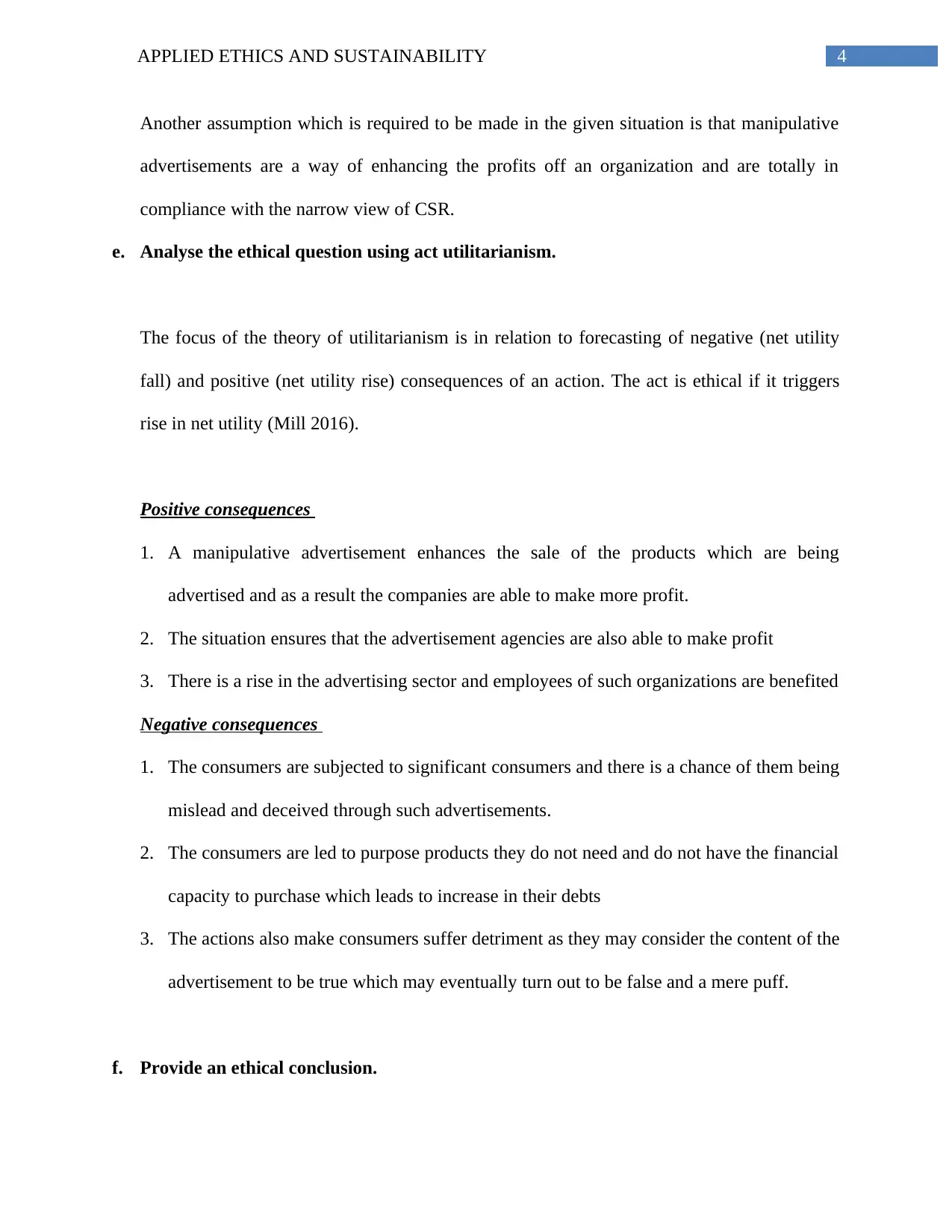
4APPLIED ETHICS AND SUSTAINABILITY
Another assumption which is required to be made in the given situation is that manipulative
advertisements are a way of enhancing the profits off an organization and are totally in
compliance with the narrow view of CSR.
e. Analyse the ethical question using act utilitarianism.
The focus of the theory of utilitarianism is in relation to forecasting of negative (net utility
fall) and positive (net utility rise) consequences of an action. The act is ethical if it triggers
rise in net utility (Mill 2016).
Positive consequences
1. A manipulative advertisement enhances the sale of the products which are being
advertised and as a result the companies are able to make more profit.
2. The situation ensures that the advertisement agencies are also able to make profit
3. There is a rise in the advertising sector and employees of such organizations are benefited
Negative consequences
1. The consumers are subjected to significant consumers and there is a chance of them being
mislead and deceived through such advertisements.
2. The consumers are led to purpose products they do not need and do not have the financial
capacity to purchase which leads to increase in their debts
3. The actions also make consumers suffer detriment as they may consider the content of the
advertisement to be true which may eventually turn out to be false and a mere puff.
f. Provide an ethical conclusion.
Another assumption which is required to be made in the given situation is that manipulative
advertisements are a way of enhancing the profits off an organization and are totally in
compliance with the narrow view of CSR.
e. Analyse the ethical question using act utilitarianism.
The focus of the theory of utilitarianism is in relation to forecasting of negative (net utility
fall) and positive (net utility rise) consequences of an action. The act is ethical if it triggers
rise in net utility (Mill 2016).
Positive consequences
1. A manipulative advertisement enhances the sale of the products which are being
advertised and as a result the companies are able to make more profit.
2. The situation ensures that the advertisement agencies are also able to make profit
3. There is a rise in the advertising sector and employees of such organizations are benefited
Negative consequences
1. The consumers are subjected to significant consumers and there is a chance of them being
mislead and deceived through such advertisements.
2. The consumers are led to purpose products they do not need and do not have the financial
capacity to purchase which leads to increase in their debts
3. The actions also make consumers suffer detriment as they may consider the content of the
advertisement to be true which may eventually turn out to be false and a mere puff.
f. Provide an ethical conclusion.
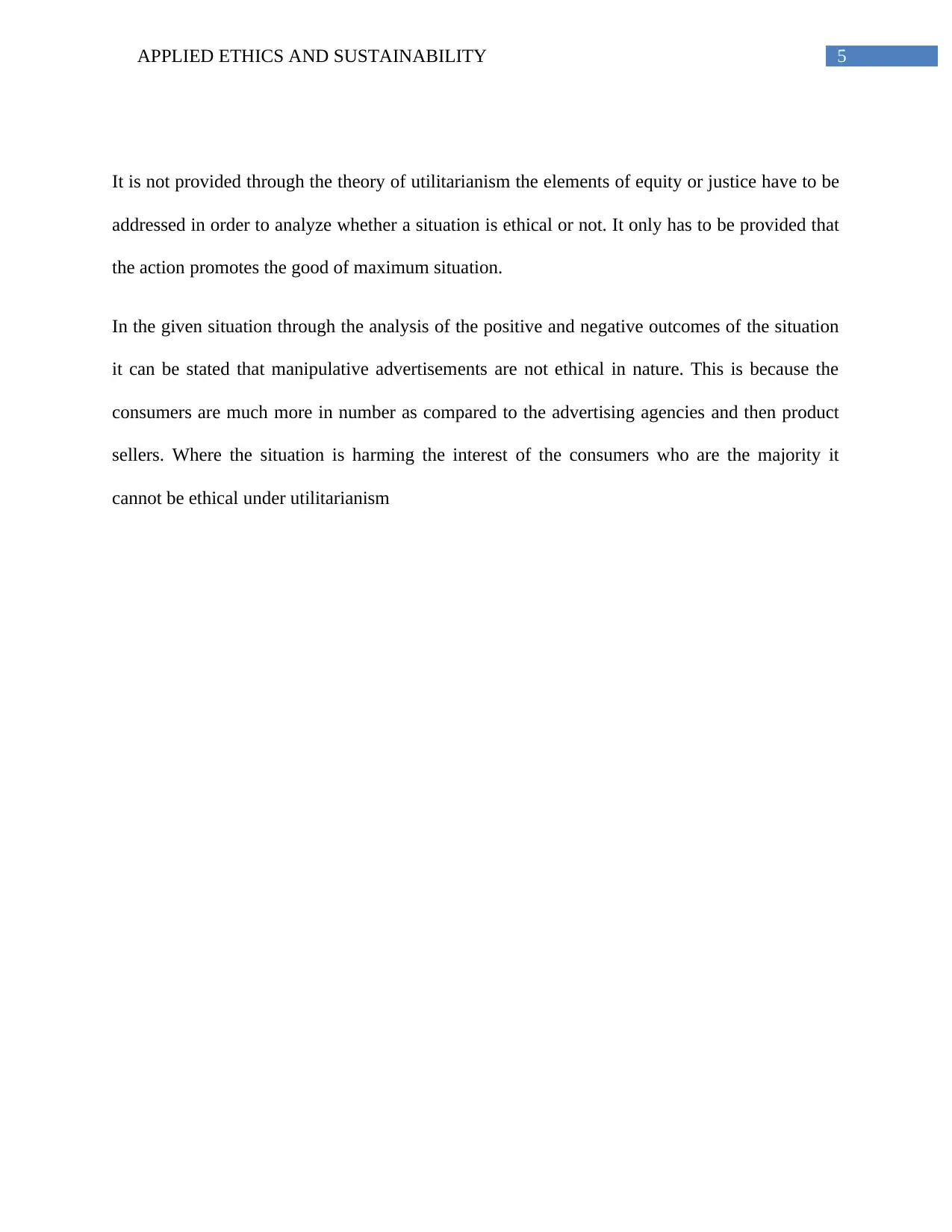
5APPLIED ETHICS AND SUSTAINABILITY
It is not provided through the theory of utilitarianism the elements of equity or justice have to be
addressed in order to analyze whether a situation is ethical or not. It only has to be provided that
the action promotes the good of maximum situation.
In the given situation through the analysis of the positive and negative outcomes of the situation
it can be stated that manipulative advertisements are not ethical in nature. This is because the
consumers are much more in number as compared to the advertising agencies and then product
sellers. Where the situation is harming the interest of the consumers who are the majority it
cannot be ethical under utilitarianism
It is not provided through the theory of utilitarianism the elements of equity or justice have to be
addressed in order to analyze whether a situation is ethical or not. It only has to be provided that
the action promotes the good of maximum situation.
In the given situation through the analysis of the positive and negative outcomes of the situation
it can be stated that manipulative advertisements are not ethical in nature. This is because the
consumers are much more in number as compared to the advertising agencies and then product
sellers. Where the situation is harming the interest of the consumers who are the majority it
cannot be ethical under utilitarianism
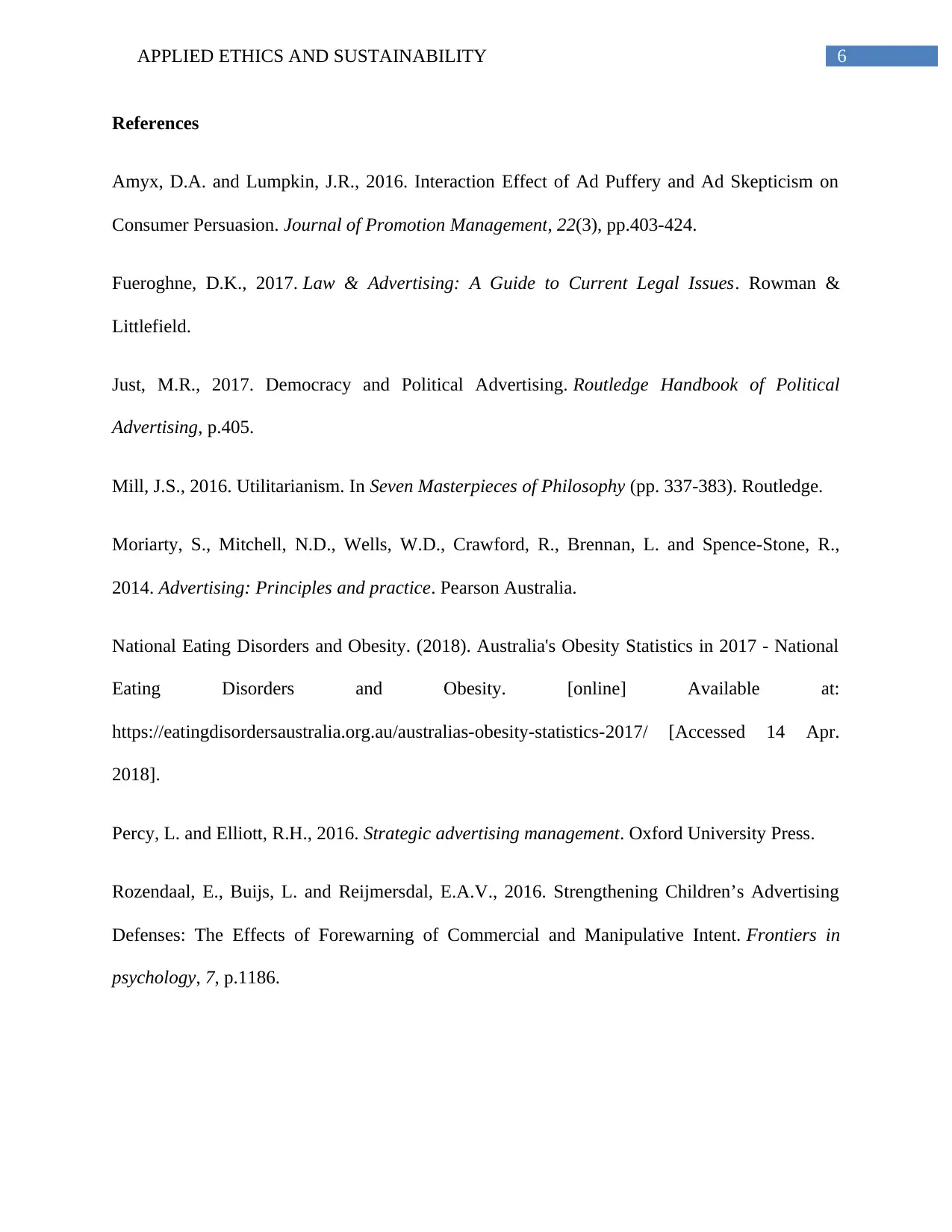
6APPLIED ETHICS AND SUSTAINABILITY
References
Amyx, D.A. and Lumpkin, J.R., 2016. Interaction Effect of Ad Puffery and Ad Skepticism on
Consumer Persuasion. Journal of Promotion Management, 22(3), pp.403-424.
Fueroghne, D.K., 2017. Law & Advertising: A Guide to Current Legal Issues. Rowman &
Littlefield.
Just, M.R., 2017. Democracy and Political Advertising. Routledge Handbook of Political
Advertising, p.405.
Mill, J.S., 2016. Utilitarianism. In Seven Masterpieces of Philosophy (pp. 337-383). Routledge.
Moriarty, S., Mitchell, N.D., Wells, W.D., Crawford, R., Brennan, L. and Spence-Stone, R.,
2014. Advertising: Principles and practice. Pearson Australia.
National Eating Disorders and Obesity. (2018). Australia's Obesity Statistics in 2017 - National
Eating Disorders and Obesity. [online] Available at:
https://eatingdisordersaustralia.org.au/australias-obesity-statistics-2017/ [Accessed 14 Apr.
2018].
Percy, L. and Elliott, R.H., 2016. Strategic advertising management. Oxford University Press.
Rozendaal, E., Buijs, L. and Reijmersdal, E.A.V., 2016. Strengthening Children’s Advertising
Defenses: The Effects of Forewarning of Commercial and Manipulative Intent. Frontiers in
psychology, 7, p.1186.
References
Amyx, D.A. and Lumpkin, J.R., 2016. Interaction Effect of Ad Puffery and Ad Skepticism on
Consumer Persuasion. Journal of Promotion Management, 22(3), pp.403-424.
Fueroghne, D.K., 2017. Law & Advertising: A Guide to Current Legal Issues. Rowman &
Littlefield.
Just, M.R., 2017. Democracy and Political Advertising. Routledge Handbook of Political
Advertising, p.405.
Mill, J.S., 2016. Utilitarianism. In Seven Masterpieces of Philosophy (pp. 337-383). Routledge.
Moriarty, S., Mitchell, N.D., Wells, W.D., Crawford, R., Brennan, L. and Spence-Stone, R.,
2014. Advertising: Principles and practice. Pearson Australia.
National Eating Disorders and Obesity. (2018). Australia's Obesity Statistics in 2017 - National
Eating Disorders and Obesity. [online] Available at:
https://eatingdisordersaustralia.org.au/australias-obesity-statistics-2017/ [Accessed 14 Apr.
2018].
Percy, L. and Elliott, R.H., 2016. Strategic advertising management. Oxford University Press.
Rozendaal, E., Buijs, L. and Reijmersdal, E.A.V., 2016. Strengthening Children’s Advertising
Defenses: The Effects of Forewarning of Commercial and Manipulative Intent. Frontiers in
psychology, 7, p.1186.
Paraphrase This Document
Need a fresh take? Get an instant paraphrase of this document with our AI Paraphraser
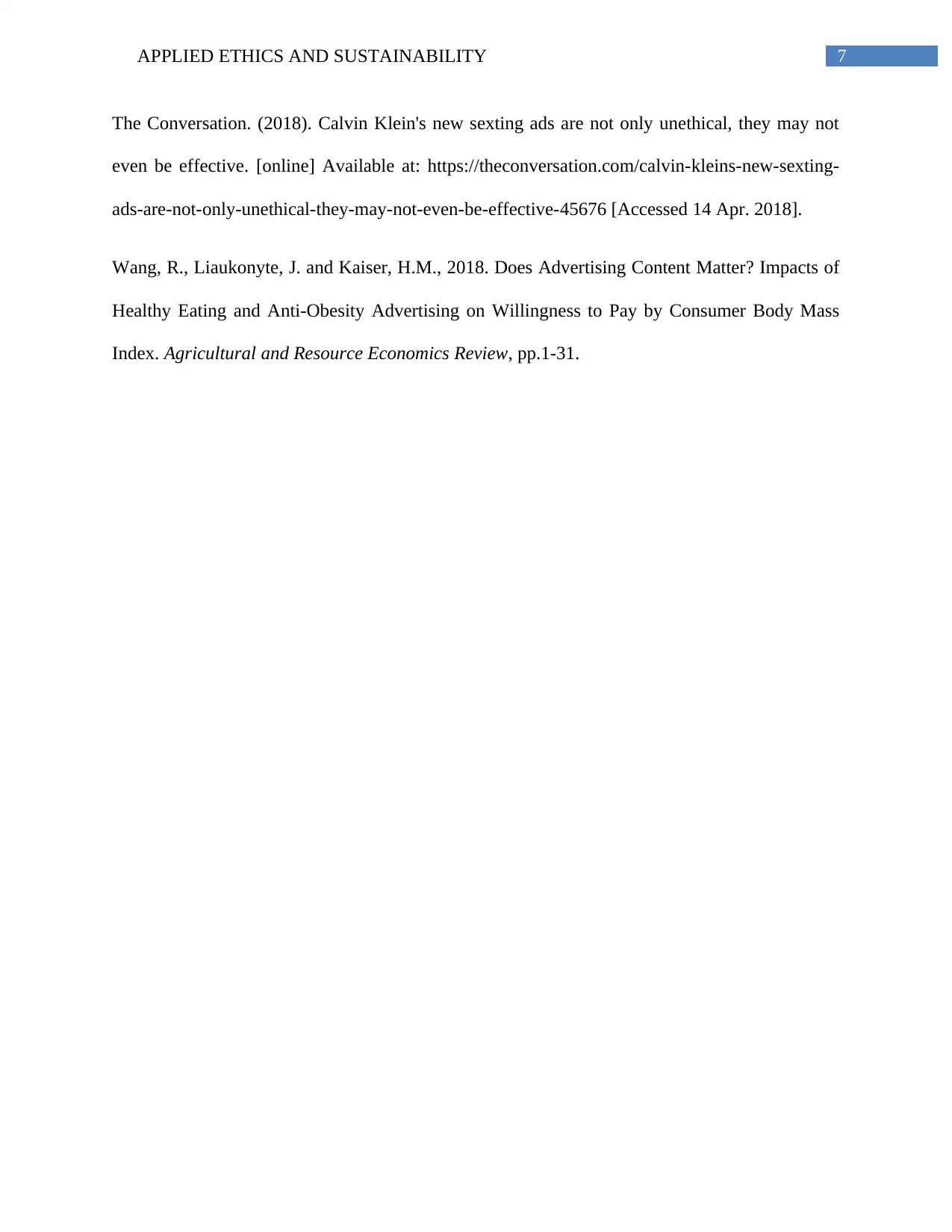
7APPLIED ETHICS AND SUSTAINABILITY
The Conversation. (2018). Calvin Klein's new sexting ads are not only unethical, they may not
even be effective. [online] Available at: https://theconversation.com/calvin-kleins-new-sexting-
ads-are-not-only-unethical-they-may-not-even-be-effective-45676 [Accessed 14 Apr. 2018].
Wang, R., Liaukonyte, J. and Kaiser, H.M., 2018. Does Advertising Content Matter? Impacts of
Healthy Eating and Anti-Obesity Advertising on Willingness to Pay by Consumer Body Mass
Index. Agricultural and Resource Economics Review, pp.1-31.
The Conversation. (2018). Calvin Klein's new sexting ads are not only unethical, they may not
even be effective. [online] Available at: https://theconversation.com/calvin-kleins-new-sexting-
ads-are-not-only-unethical-they-may-not-even-be-effective-45676 [Accessed 14 Apr. 2018].
Wang, R., Liaukonyte, J. and Kaiser, H.M., 2018. Does Advertising Content Matter? Impacts of
Healthy Eating and Anti-Obesity Advertising on Willingness to Pay by Consumer Body Mass
Index. Agricultural and Resource Economics Review, pp.1-31.
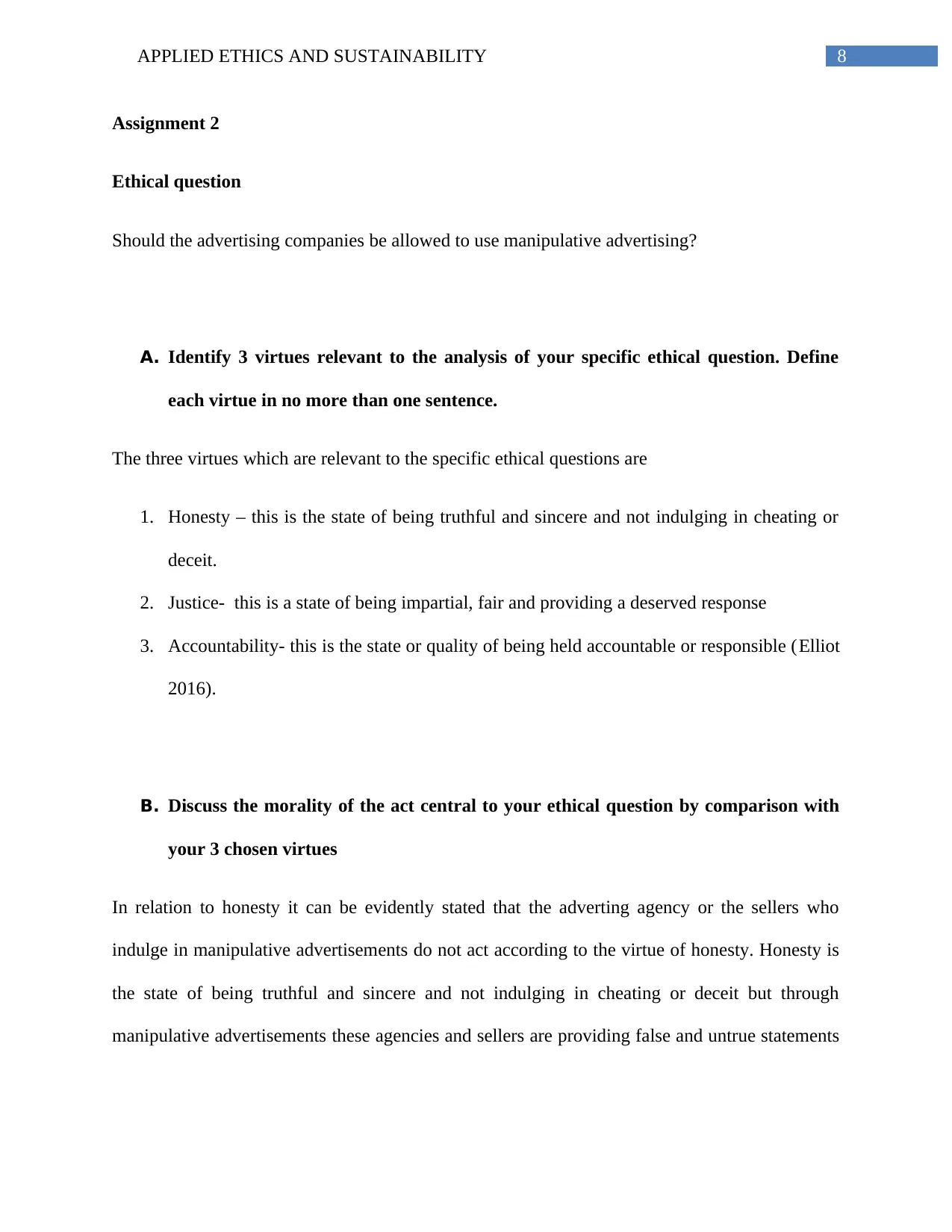
8APPLIED ETHICS AND SUSTAINABILITY
Assignment 2
Ethical question
Should the advertising companies be allowed to use manipulative advertising?
A. Identify 3 virtues relevant to the analysis of your specific ethical question. Define
each virtue in no more than one sentence.
The three virtues which are relevant to the specific ethical questions are
1. Honesty – this is the state of being truthful and sincere and not indulging in cheating or
deceit.
2. Justice- this is a state of being impartial, fair and providing a deserved response
3. Accountability- this is the state or quality of being held accountable or responsible (Elliot
2016).
B. Discuss the morality of the act central to your ethical question by comparison with
your 3 chosen virtues
In relation to honesty it can be evidently stated that the adverting agency or the sellers who
indulge in manipulative advertisements do not act according to the virtue of honesty. Honesty is
the state of being truthful and sincere and not indulging in cheating or deceit but through
manipulative advertisements these agencies and sellers are providing false and untrue statements
Assignment 2
Ethical question
Should the advertising companies be allowed to use manipulative advertising?
A. Identify 3 virtues relevant to the analysis of your specific ethical question. Define
each virtue in no more than one sentence.
The three virtues which are relevant to the specific ethical questions are
1. Honesty – this is the state of being truthful and sincere and not indulging in cheating or
deceit.
2. Justice- this is a state of being impartial, fair and providing a deserved response
3. Accountability- this is the state or quality of being held accountable or responsible (Elliot
2016).
B. Discuss the morality of the act central to your ethical question by comparison with
your 3 chosen virtues
In relation to honesty it can be evidently stated that the adverting agency or the sellers who
indulge in manipulative advertisements do not act according to the virtue of honesty. Honesty is
the state of being truthful and sincere and not indulging in cheating or deceit but through
manipulative advertisements these agencies and sellers are providing false and untrue statements
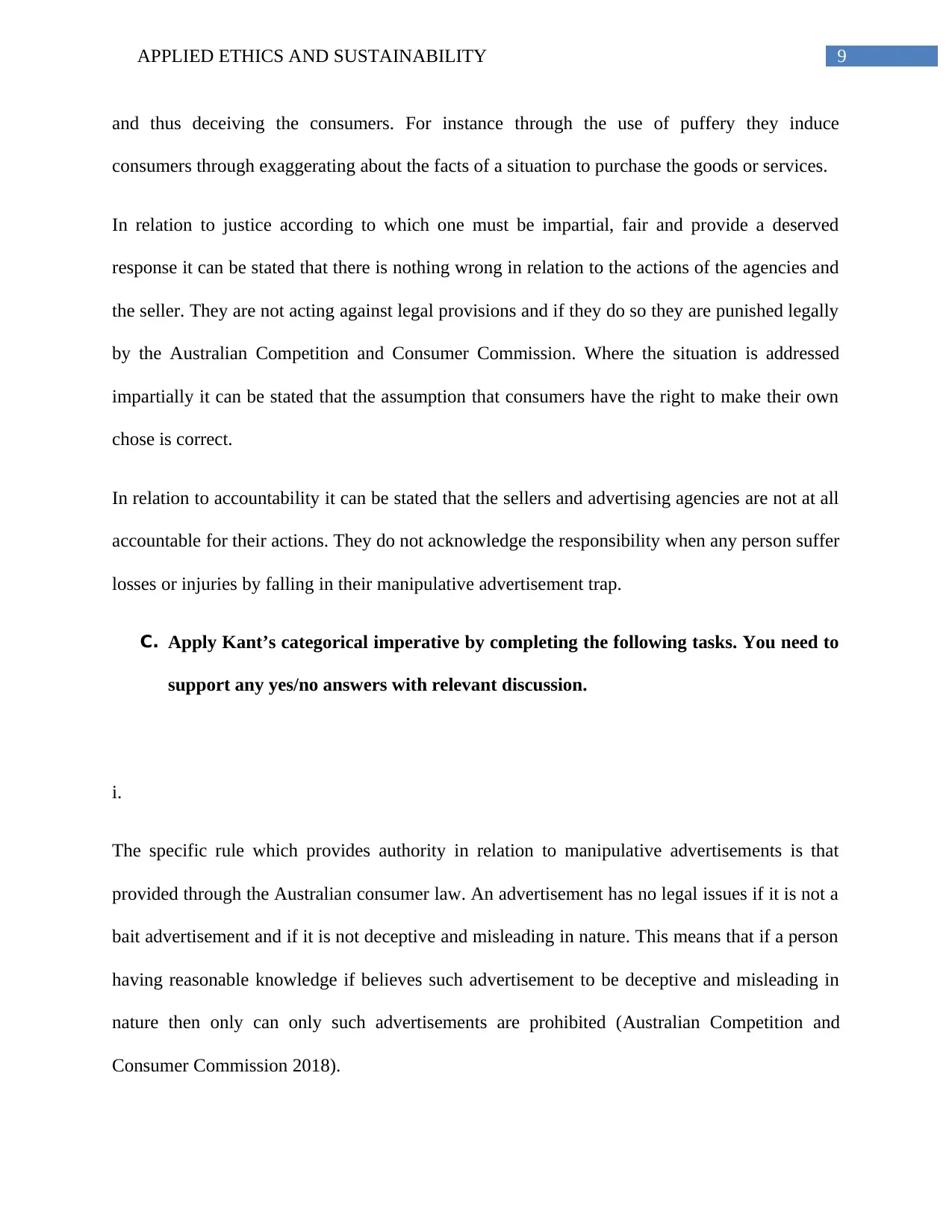
9APPLIED ETHICS AND SUSTAINABILITY
and thus deceiving the consumers. For instance through the use of puffery they induce
consumers through exaggerating about the facts of a situation to purchase the goods or services.
In relation to justice according to which one must be impartial, fair and provide a deserved
response it can be stated that there is nothing wrong in relation to the actions of the agencies and
the seller. They are not acting against legal provisions and if they do so they are punished legally
by the Australian Competition and Consumer Commission. Where the situation is addressed
impartially it can be stated that the assumption that consumers have the right to make their own
chose is correct.
In relation to accountability it can be stated that the sellers and advertising agencies are not at all
accountable for their actions. They do not acknowledge the responsibility when any person suffer
losses or injuries by falling in their manipulative advertisement trap.
C. Apply Kant’s categorical imperative by completing the following tasks. You need to
support any yes/no answers with relevant discussion.
i.
The specific rule which provides authority in relation to manipulative advertisements is that
provided through the Australian consumer law. An advertisement has no legal issues if it is not a
bait advertisement and if it is not deceptive and misleading in nature. This means that if a person
having reasonable knowledge if believes such advertisement to be deceptive and misleading in
nature then only can only such advertisements are prohibited (Australian Competition and
Consumer Commission 2018).
and thus deceiving the consumers. For instance through the use of puffery they induce
consumers through exaggerating about the facts of a situation to purchase the goods or services.
In relation to justice according to which one must be impartial, fair and provide a deserved
response it can be stated that there is nothing wrong in relation to the actions of the agencies and
the seller. They are not acting against legal provisions and if they do so they are punished legally
by the Australian Competition and Consumer Commission. Where the situation is addressed
impartially it can be stated that the assumption that consumers have the right to make their own
chose is correct.
In relation to accountability it can be stated that the sellers and advertising agencies are not at all
accountable for their actions. They do not acknowledge the responsibility when any person suffer
losses or injuries by falling in their manipulative advertisement trap.
C. Apply Kant’s categorical imperative by completing the following tasks. You need to
support any yes/no answers with relevant discussion.
i.
The specific rule which provides authority in relation to manipulative advertisements is that
provided through the Australian consumer law. An advertisement has no legal issues if it is not a
bait advertisement and if it is not deceptive and misleading in nature. This means that if a person
having reasonable knowledge if believes such advertisement to be deceptive and misleading in
nature then only can only such advertisements are prohibited (Australian Competition and
Consumer Commission 2018).
Secure Best Marks with AI Grader
Need help grading? Try our AI Grader for instant feedback on your assignments.
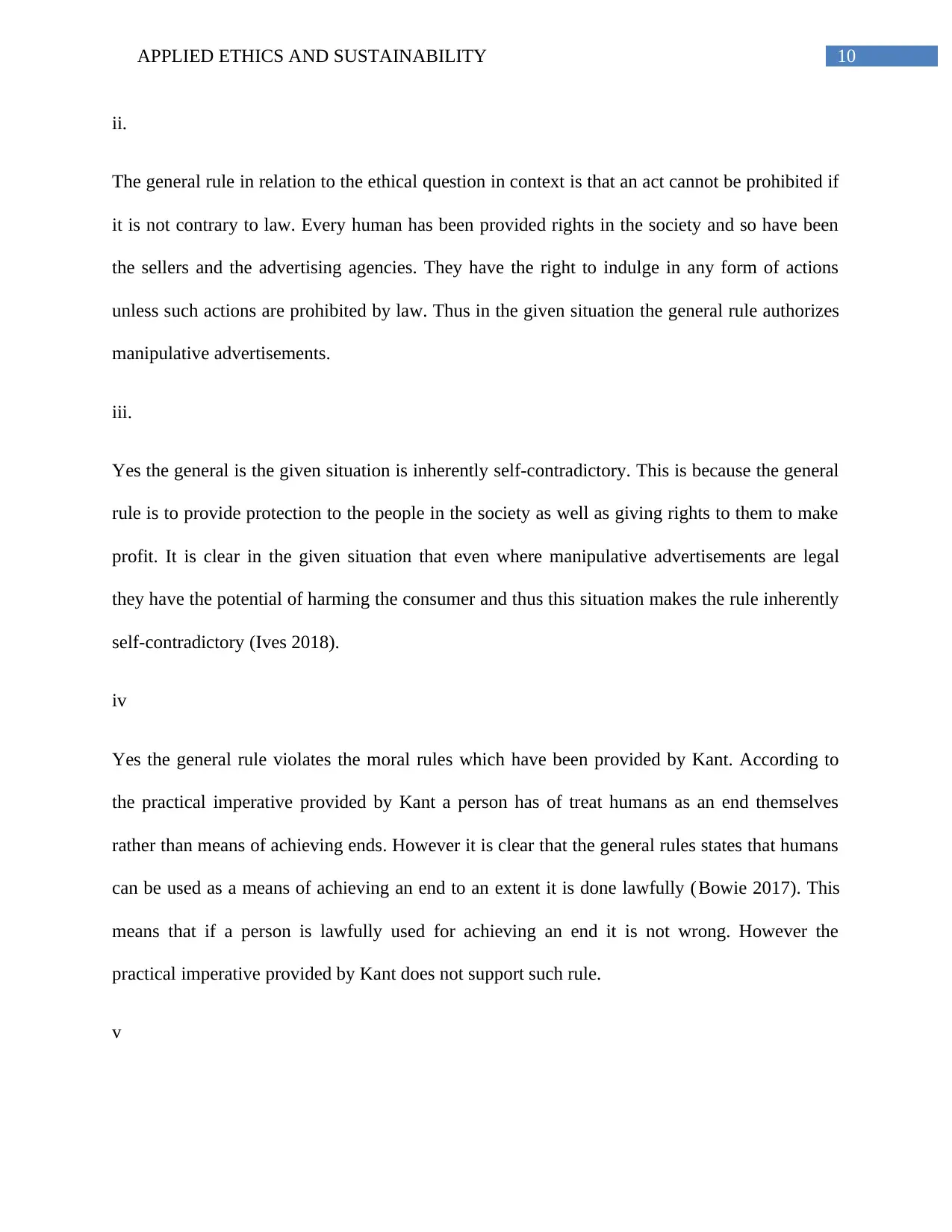
10APPLIED ETHICS AND SUSTAINABILITY
ii.
The general rule in relation to the ethical question in context is that an act cannot be prohibited if
it is not contrary to law. Every human has been provided rights in the society and so have been
the sellers and the advertising agencies. They have the right to indulge in any form of actions
unless such actions are prohibited by law. Thus in the given situation the general rule authorizes
manipulative advertisements.
iii.
Yes the general is the given situation is inherently self-contradictory. This is because the general
rule is to provide protection to the people in the society as well as giving rights to them to make
profit. It is clear in the given situation that even where manipulative advertisements are legal
they have the potential of harming the consumer and thus this situation makes the rule inherently
self-contradictory (Ives 2018).
iv
Yes the general rule violates the moral rules which have been provided by Kant. According to
the practical imperative provided by Kant a person has of treat humans as an end themselves
rather than means of achieving ends. However it is clear that the general rules states that humans
can be used as a means of achieving an end to an extent it is done lawfully ( Bowie 2017). This
means that if a person is lawfully used for achieving an end it is not wrong. However the
practical imperative provided by Kant does not support such rule.
v
ii.
The general rule in relation to the ethical question in context is that an act cannot be prohibited if
it is not contrary to law. Every human has been provided rights in the society and so have been
the sellers and the advertising agencies. They have the right to indulge in any form of actions
unless such actions are prohibited by law. Thus in the given situation the general rule authorizes
manipulative advertisements.
iii.
Yes the general is the given situation is inherently self-contradictory. This is because the general
rule is to provide protection to the people in the society as well as giving rights to them to make
profit. It is clear in the given situation that even where manipulative advertisements are legal
they have the potential of harming the consumer and thus this situation makes the rule inherently
self-contradictory (Ives 2018).
iv
Yes the general rule violates the moral rules which have been provided by Kant. According to
the practical imperative provided by Kant a person has of treat humans as an end themselves
rather than means of achieving ends. However it is clear that the general rules states that humans
can be used as a means of achieving an end to an extent it is done lawfully ( Bowie 2017). This
means that if a person is lawfully used for achieving an end it is not wrong. However the
practical imperative provided by Kant does not support such rule.
v
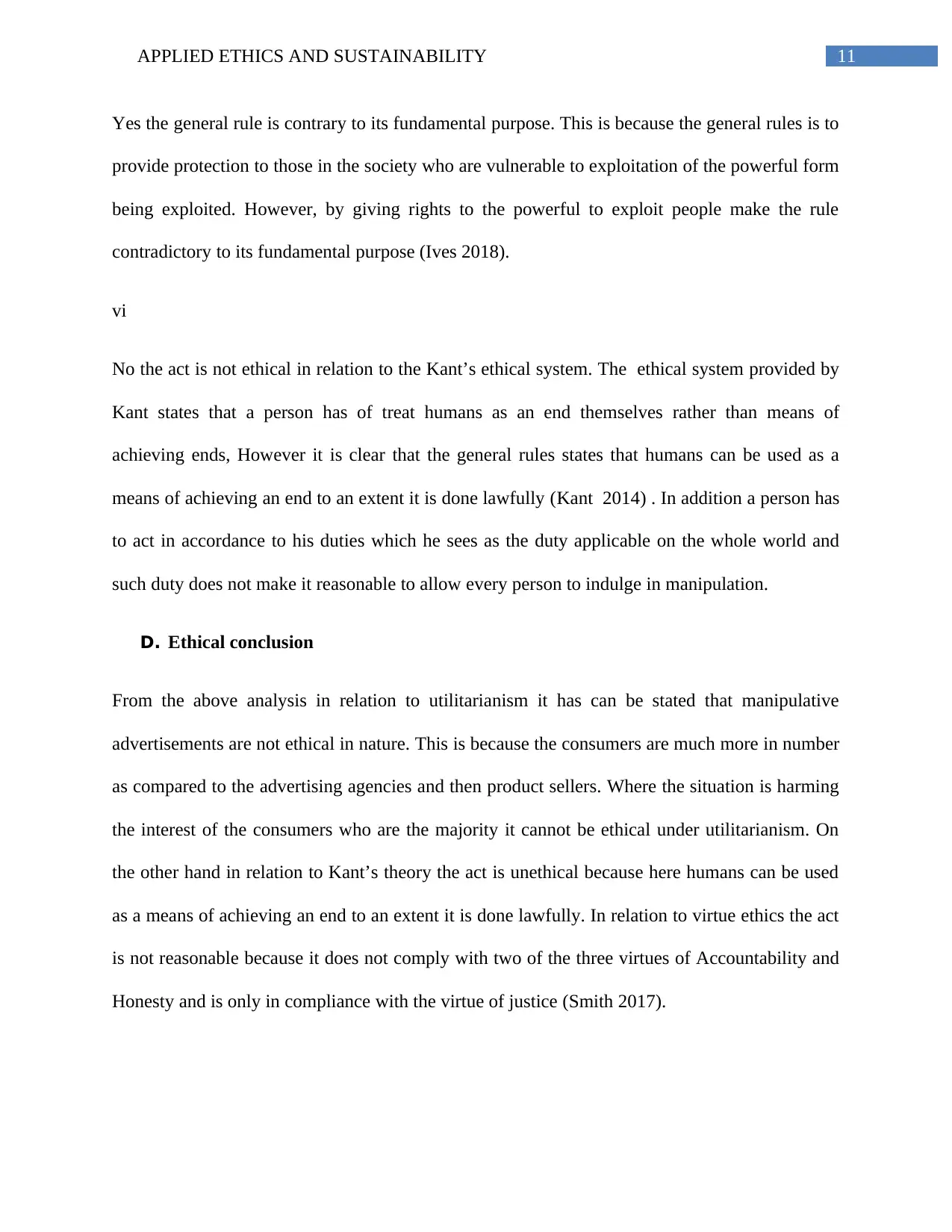
11APPLIED ETHICS AND SUSTAINABILITY
Yes the general rule is contrary to its fundamental purpose. This is because the general rules is to
provide protection to those in the society who are vulnerable to exploitation of the powerful form
being exploited. However, by giving rights to the powerful to exploit people make the rule
contradictory to its fundamental purpose (Ives 2018).
vi
No the act is not ethical in relation to the Kant’s ethical system. The ethical system provided by
Kant states that a person has of treat humans as an end themselves rather than means of
achieving ends, However it is clear that the general rules states that humans can be used as a
means of achieving an end to an extent it is done lawfully (Kant 2014) . In addition a person has
to act in accordance to his duties which he sees as the duty applicable on the whole world and
such duty does not make it reasonable to allow every person to indulge in manipulation.
D. Ethical conclusion
From the above analysis in relation to utilitarianism it has can be stated that manipulative
advertisements are not ethical in nature. This is because the consumers are much more in number
as compared to the advertising agencies and then product sellers. Where the situation is harming
the interest of the consumers who are the majority it cannot be ethical under utilitarianism. On
the other hand in relation to Kant’s theory the act is unethical because here humans can be used
as a means of achieving an end to an extent it is done lawfully. In relation to virtue ethics the act
is not reasonable because it does not comply with two of the three virtues of Accountability and
Honesty and is only in compliance with the virtue of justice (Smith 2017).
Yes the general rule is contrary to its fundamental purpose. This is because the general rules is to
provide protection to those in the society who are vulnerable to exploitation of the powerful form
being exploited. However, by giving rights to the powerful to exploit people make the rule
contradictory to its fundamental purpose (Ives 2018).
vi
No the act is not ethical in relation to the Kant’s ethical system. The ethical system provided by
Kant states that a person has of treat humans as an end themselves rather than means of
achieving ends, However it is clear that the general rules states that humans can be used as a
means of achieving an end to an extent it is done lawfully (Kant 2014) . In addition a person has
to act in accordance to his duties which he sees as the duty applicable on the whole world and
such duty does not make it reasonable to allow every person to indulge in manipulation.
D. Ethical conclusion
From the above analysis in relation to utilitarianism it has can be stated that manipulative
advertisements are not ethical in nature. This is because the consumers are much more in number
as compared to the advertising agencies and then product sellers. Where the situation is harming
the interest of the consumers who are the majority it cannot be ethical under utilitarianism. On
the other hand in relation to Kant’s theory the act is unethical because here humans can be used
as a means of achieving an end to an extent it is done lawfully. In relation to virtue ethics the act
is not reasonable because it does not comply with two of the three virtues of Accountability and
Honesty and is only in compliance with the virtue of justice (Smith 2017).
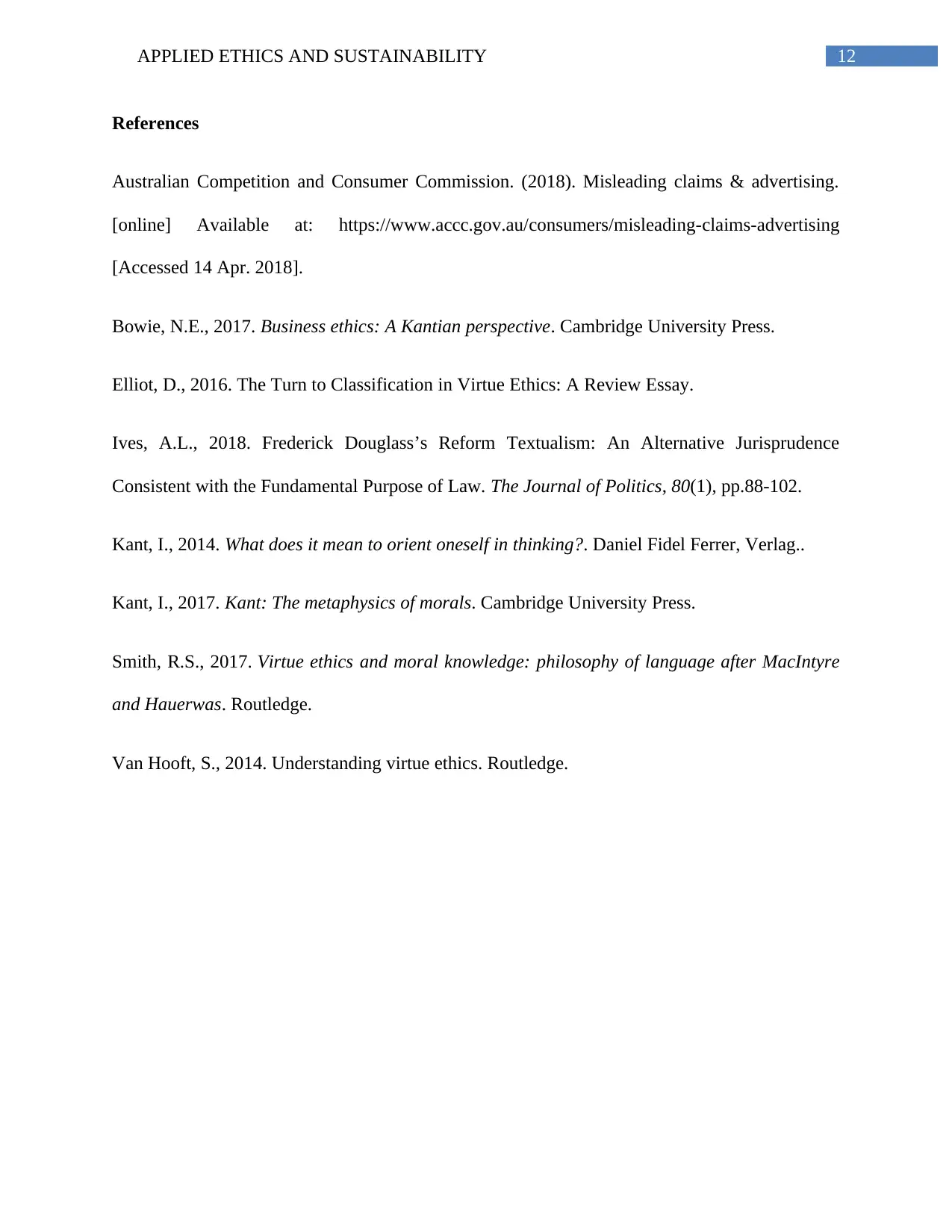
12APPLIED ETHICS AND SUSTAINABILITY
References
Australian Competition and Consumer Commission. (2018). Misleading claims & advertising.
[online] Available at: https://www.accc.gov.au/consumers/misleading-claims-advertising
[Accessed 14 Apr. 2018].
Bowie, N.E., 2017. Business ethics: A Kantian perspective. Cambridge University Press.
Elliot, D., 2016. The Turn to Classification in Virtue Ethics: A Review Essay.
Ives, A.L., 2018. Frederick Douglass’s Reform Textualism: An Alternative Jurisprudence
Consistent with the Fundamental Purpose of Law. The Journal of Politics, 80(1), pp.88-102.
Kant, I., 2014. What does it mean to orient oneself in thinking?. Daniel Fidel Ferrer, Verlag..
Kant, I., 2017. Kant: The metaphysics of morals. Cambridge University Press.
Smith, R.S., 2017. Virtue ethics and moral knowledge: philosophy of language after MacIntyre
and Hauerwas. Routledge.
Van Hooft, S., 2014. Understanding virtue ethics. Routledge.
References
Australian Competition and Consumer Commission. (2018). Misleading claims & advertising.
[online] Available at: https://www.accc.gov.au/consumers/misleading-claims-advertising
[Accessed 14 Apr. 2018].
Bowie, N.E., 2017. Business ethics: A Kantian perspective. Cambridge University Press.
Elliot, D., 2016. The Turn to Classification in Virtue Ethics: A Review Essay.
Ives, A.L., 2018. Frederick Douglass’s Reform Textualism: An Alternative Jurisprudence
Consistent with the Fundamental Purpose of Law. The Journal of Politics, 80(1), pp.88-102.
Kant, I., 2014. What does it mean to orient oneself in thinking?. Daniel Fidel Ferrer, Verlag..
Kant, I., 2017. Kant: The metaphysics of morals. Cambridge University Press.
Smith, R.S., 2017. Virtue ethics and moral knowledge: philosophy of language after MacIntyre
and Hauerwas. Routledge.
Van Hooft, S., 2014. Understanding virtue ethics. Routledge.
Paraphrase This Document
Need a fresh take? Get an instant paraphrase of this document with our AI Paraphraser
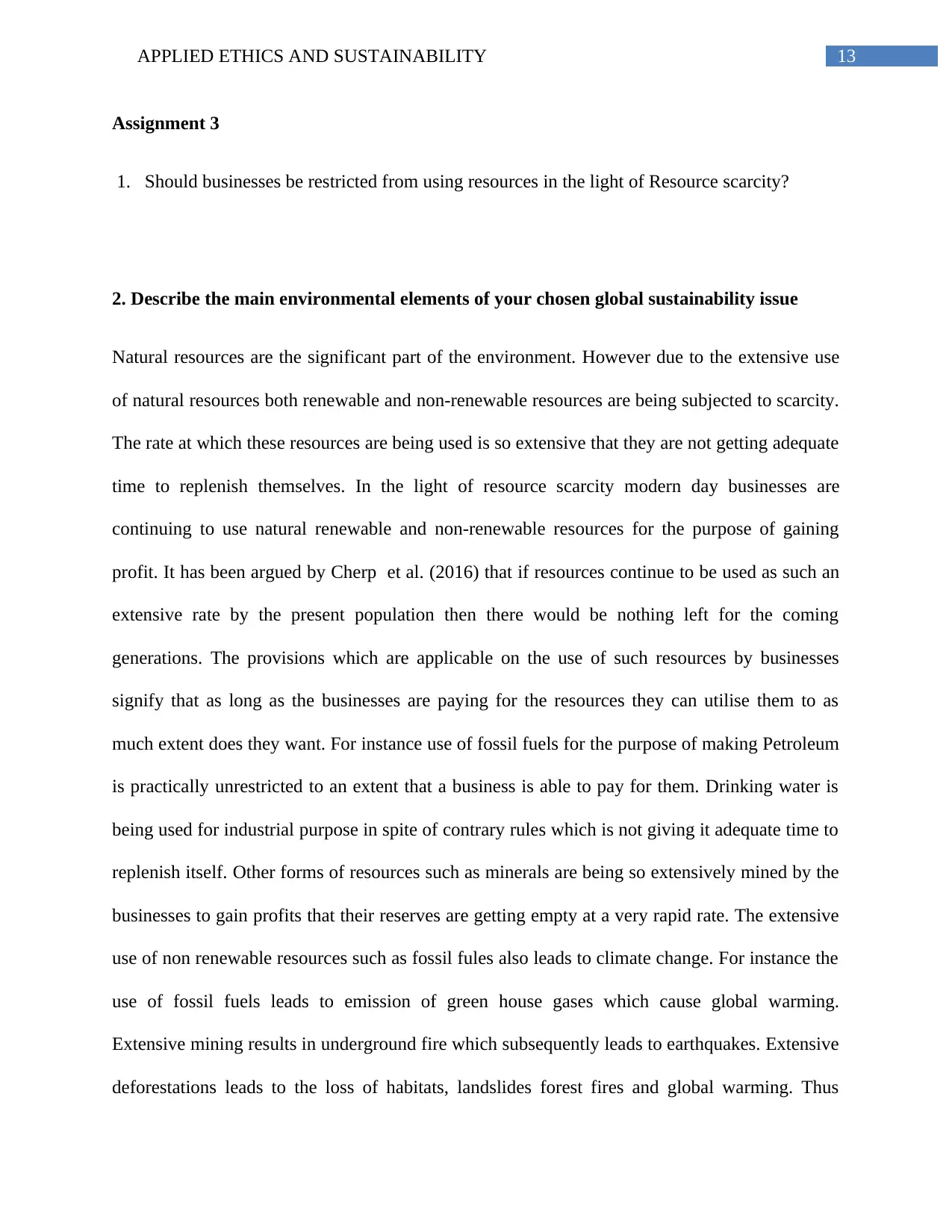
13APPLIED ETHICS AND SUSTAINABILITY
Assignment 3
1. Should businesses be restricted from using resources in the light of Resource scarcity?
2. Describe the main environmental elements of your chosen global sustainability issue
Natural resources are the significant part of the environment. However due to the extensive use
of natural resources both renewable and non-renewable resources are being subjected to scarcity.
The rate at which these resources are being used is so extensive that they are not getting adequate
time to replenish themselves. In the light of resource scarcity modern day businesses are
continuing to use natural renewable and non-renewable resources for the purpose of gaining
profit. It has been argued by Cherp et al. (2016) that if resources continue to be used as such an
extensive rate by the present population then there would be nothing left for the coming
generations. The provisions which are applicable on the use of such resources by businesses
signify that as long as the businesses are paying for the resources they can utilise them to as
much extent does they want. For instance use of fossil fuels for the purpose of making Petroleum
is practically unrestricted to an extent that a business is able to pay for them. Drinking water is
being used for industrial purpose in spite of contrary rules which is not giving it adequate time to
replenish itself. Other forms of resources such as minerals are being so extensively mined by the
businesses to gain profits that their reserves are getting empty at a very rapid rate. The extensive
use of non renewable resources such as fossil fules also leads to climate change. For instance the
use of fossil fuels leads to emission of green house gases which cause global warming.
Extensive mining results in underground fire which subsequently leads to earthquakes. Extensive
deforestations leads to the loss of habitats, landslides forest fires and global warming. Thus
Assignment 3
1. Should businesses be restricted from using resources in the light of Resource scarcity?
2. Describe the main environmental elements of your chosen global sustainability issue
Natural resources are the significant part of the environment. However due to the extensive use
of natural resources both renewable and non-renewable resources are being subjected to scarcity.
The rate at which these resources are being used is so extensive that they are not getting adequate
time to replenish themselves. In the light of resource scarcity modern day businesses are
continuing to use natural renewable and non-renewable resources for the purpose of gaining
profit. It has been argued by Cherp et al. (2016) that if resources continue to be used as such an
extensive rate by the present population then there would be nothing left for the coming
generations. The provisions which are applicable on the use of such resources by businesses
signify that as long as the businesses are paying for the resources they can utilise them to as
much extent does they want. For instance use of fossil fuels for the purpose of making Petroleum
is practically unrestricted to an extent that a business is able to pay for them. Drinking water is
being used for industrial purpose in spite of contrary rules which is not giving it adequate time to
replenish itself. Other forms of resources such as minerals are being so extensively mined by the
businesses to gain profits that their reserves are getting empty at a very rapid rate. The extensive
use of non renewable resources such as fossil fules also leads to climate change. For instance the
use of fossil fuels leads to emission of green house gases which cause global warming.
Extensive mining results in underground fire which subsequently leads to earthquakes. Extensive
deforestations leads to the loss of habitats, landslides forest fires and global warming. Thus
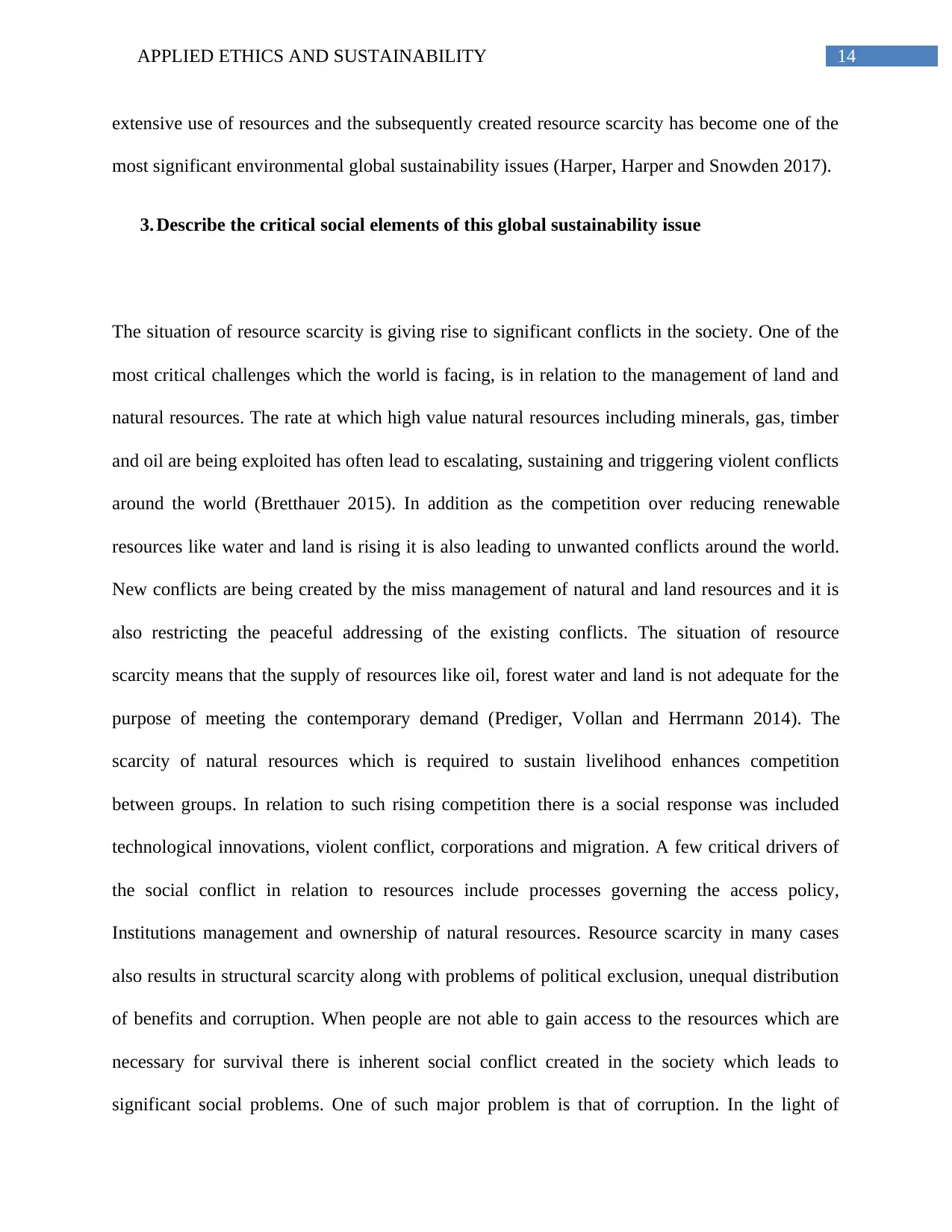
14APPLIED ETHICS AND SUSTAINABILITY
extensive use of resources and the subsequently created resource scarcity has become one of the
most significant environmental global sustainability issues (Harper, Harper and Snowden 2017).
3. Describe the critical social elements of this global sustainability issue
The situation of resource scarcity is giving rise to significant conflicts in the society. One of the
most critical challenges which the world is facing, is in relation to the management of land and
natural resources. The rate at which high value natural resources including minerals, gas, timber
and oil are being exploited has often lead to escalating, sustaining and triggering violent conflicts
around the world (Bretthauer 2015). In addition as the competition over reducing renewable
resources like water and land is rising it is also leading to unwanted conflicts around the world.
New conflicts are being created by the miss management of natural and land resources and it is
also restricting the peaceful addressing of the existing conflicts. The situation of resource
scarcity means that the supply of resources like oil, forest water and land is not adequate for the
purpose of meeting the contemporary demand (Prediger, Vollan and Herrmann 2014). The
scarcity of natural resources which is required to sustain livelihood enhances competition
between groups. In relation to such rising competition there is a social response was included
technological innovations, violent conflict, corporations and migration. A few critical drivers of
the social conflict in relation to resources include processes governing the access policy,
Institutions management and ownership of natural resources. Resource scarcity in many cases
also results in structural scarcity along with problems of political exclusion, unequal distribution
of benefits and corruption. When people are not able to gain access to the resources which are
necessary for survival there is inherent social conflict created in the society which leads to
significant social problems. One of such major problem is that of corruption. In the light of
extensive use of resources and the subsequently created resource scarcity has become one of the
most significant environmental global sustainability issues (Harper, Harper and Snowden 2017).
3. Describe the critical social elements of this global sustainability issue
The situation of resource scarcity is giving rise to significant conflicts in the society. One of the
most critical challenges which the world is facing, is in relation to the management of land and
natural resources. The rate at which high value natural resources including minerals, gas, timber
and oil are being exploited has often lead to escalating, sustaining and triggering violent conflicts
around the world (Bretthauer 2015). In addition as the competition over reducing renewable
resources like water and land is rising it is also leading to unwanted conflicts around the world.
New conflicts are being created by the miss management of natural and land resources and it is
also restricting the peaceful addressing of the existing conflicts. The situation of resource
scarcity means that the supply of resources like oil, forest water and land is not adequate for the
purpose of meeting the contemporary demand (Prediger, Vollan and Herrmann 2014). The
scarcity of natural resources which is required to sustain livelihood enhances competition
between groups. In relation to such rising competition there is a social response was included
technological innovations, violent conflict, corporations and migration. A few critical drivers of
the social conflict in relation to resources include processes governing the access policy,
Institutions management and ownership of natural resources. Resource scarcity in many cases
also results in structural scarcity along with problems of political exclusion, unequal distribution
of benefits and corruption. When people are not able to gain access to the resources which are
necessary for survival there is inherent social conflict created in the society which leads to
significant social problems. One of such major problem is that of corruption. In the light of
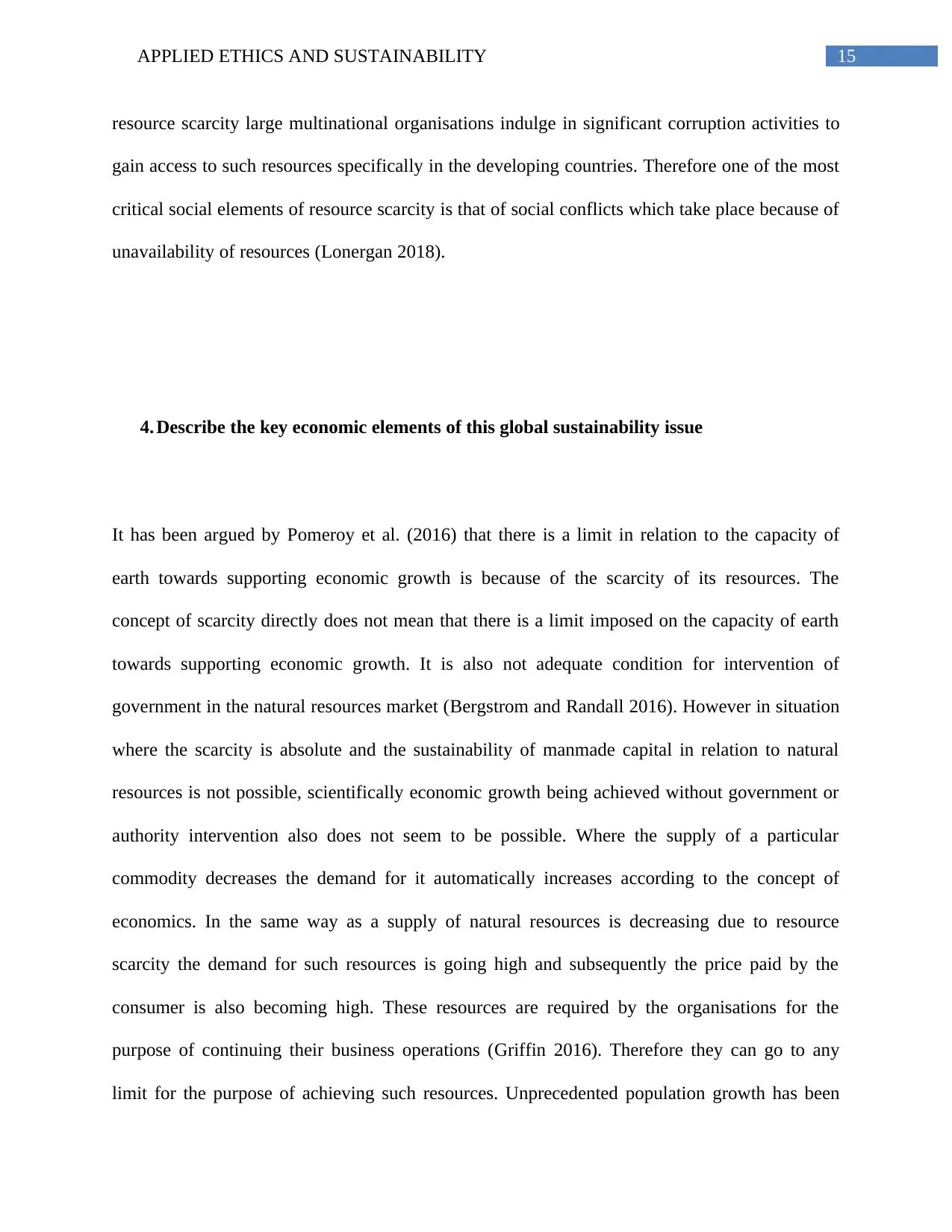
15APPLIED ETHICS AND SUSTAINABILITY
resource scarcity large multinational organisations indulge in significant corruption activities to
gain access to such resources specifically in the developing countries. Therefore one of the most
critical social elements of resource scarcity is that of social conflicts which take place because of
unavailability of resources (Lonergan 2018).
4. Describe the key economic elements of this global sustainability issue
It has been argued by Pomeroy et al. (2016) that there is a limit in relation to the capacity of
earth towards supporting economic growth is because of the scarcity of its resources. The
concept of scarcity directly does not mean that there is a limit imposed on the capacity of earth
towards supporting economic growth. It is also not adequate condition for intervention of
government in the natural resources market (Bergstrom and Randall 2016). However in situation
where the scarcity is absolute and the sustainability of manmade capital in relation to natural
resources is not possible, scientifically economic growth being achieved without government or
authority intervention also does not seem to be possible. Where the supply of a particular
commodity decreases the demand for it automatically increases according to the concept of
economics. In the same way as a supply of natural resources is decreasing due to resource
scarcity the demand for such resources is going high and subsequently the price paid by the
consumer is also becoming high. These resources are required by the organisations for the
purpose of continuing their business operations (Griffin 2016). Therefore they can go to any
limit for the purpose of achieving such resources. Unprecedented population growth has been
resource scarcity large multinational organisations indulge in significant corruption activities to
gain access to such resources specifically in the developing countries. Therefore one of the most
critical social elements of resource scarcity is that of social conflicts which take place because of
unavailability of resources (Lonergan 2018).
4. Describe the key economic elements of this global sustainability issue
It has been argued by Pomeroy et al. (2016) that there is a limit in relation to the capacity of
earth towards supporting economic growth is because of the scarcity of its resources. The
concept of scarcity directly does not mean that there is a limit imposed on the capacity of earth
towards supporting economic growth. It is also not adequate condition for intervention of
government in the natural resources market (Bergstrom and Randall 2016). However in situation
where the scarcity is absolute and the sustainability of manmade capital in relation to natural
resources is not possible, scientifically economic growth being achieved without government or
authority intervention also does not seem to be possible. Where the supply of a particular
commodity decreases the demand for it automatically increases according to the concept of
economics. In the same way as a supply of natural resources is decreasing due to resource
scarcity the demand for such resources is going high and subsequently the price paid by the
consumer is also becoming high. These resources are required by the organisations for the
purpose of continuing their business operations (Griffin 2016). Therefore they can go to any
limit for the purpose of achieving such resources. Unprecedented population growth has been
Secure Best Marks with AI Grader
Need help grading? Try our AI Grader for instant feedback on your assignments.
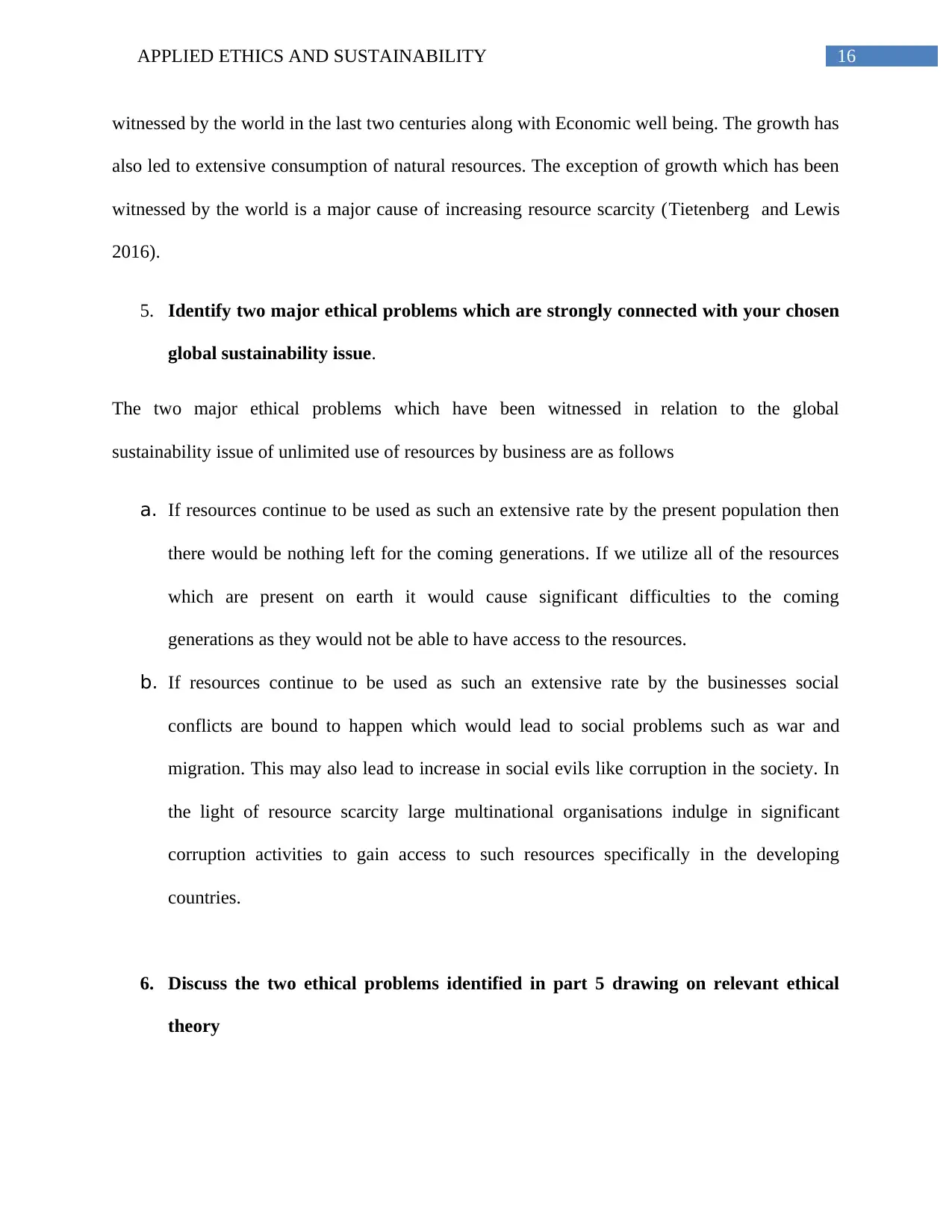
16APPLIED ETHICS AND SUSTAINABILITY
witnessed by the world in the last two centuries along with Economic well being. The growth has
also led to extensive consumption of natural resources. The exception of growth which has been
witnessed by the world is a major cause of increasing resource scarcity (Tietenberg and Lewis
2016).
5. Identify two major ethical problems which are strongly connected with your chosen
global sustainability issue.
The two major ethical problems which have been witnessed in relation to the global
sustainability issue of unlimited use of resources by business are as follows
a. If resources continue to be used as such an extensive rate by the present population then
there would be nothing left for the coming generations. If we utilize all of the resources
which are present on earth it would cause significant difficulties to the coming
generations as they would not be able to have access to the resources.
b. If resources continue to be used as such an extensive rate by the businesses social
conflicts are bound to happen which would lead to social problems such as war and
migration. This may also lead to increase in social evils like corruption in the society. In
the light of resource scarcity large multinational organisations indulge in significant
corruption activities to gain access to such resources specifically in the developing
countries.
6. Discuss the two ethical problems identified in part 5 drawing on relevant ethical
theory
witnessed by the world in the last two centuries along with Economic well being. The growth has
also led to extensive consumption of natural resources. The exception of growth which has been
witnessed by the world is a major cause of increasing resource scarcity (Tietenberg and Lewis
2016).
5. Identify two major ethical problems which are strongly connected with your chosen
global sustainability issue.
The two major ethical problems which have been witnessed in relation to the global
sustainability issue of unlimited use of resources by business are as follows
a. If resources continue to be used as such an extensive rate by the present population then
there would be nothing left for the coming generations. If we utilize all of the resources
which are present on earth it would cause significant difficulties to the coming
generations as they would not be able to have access to the resources.
b. If resources continue to be used as such an extensive rate by the businesses social
conflicts are bound to happen which would lead to social problems such as war and
migration. This may also lead to increase in social evils like corruption in the society. In
the light of resource scarcity large multinational organisations indulge in significant
corruption activities to gain access to such resources specifically in the developing
countries.
6. Discuss the two ethical problems identified in part 5 drawing on relevant ethical
theory
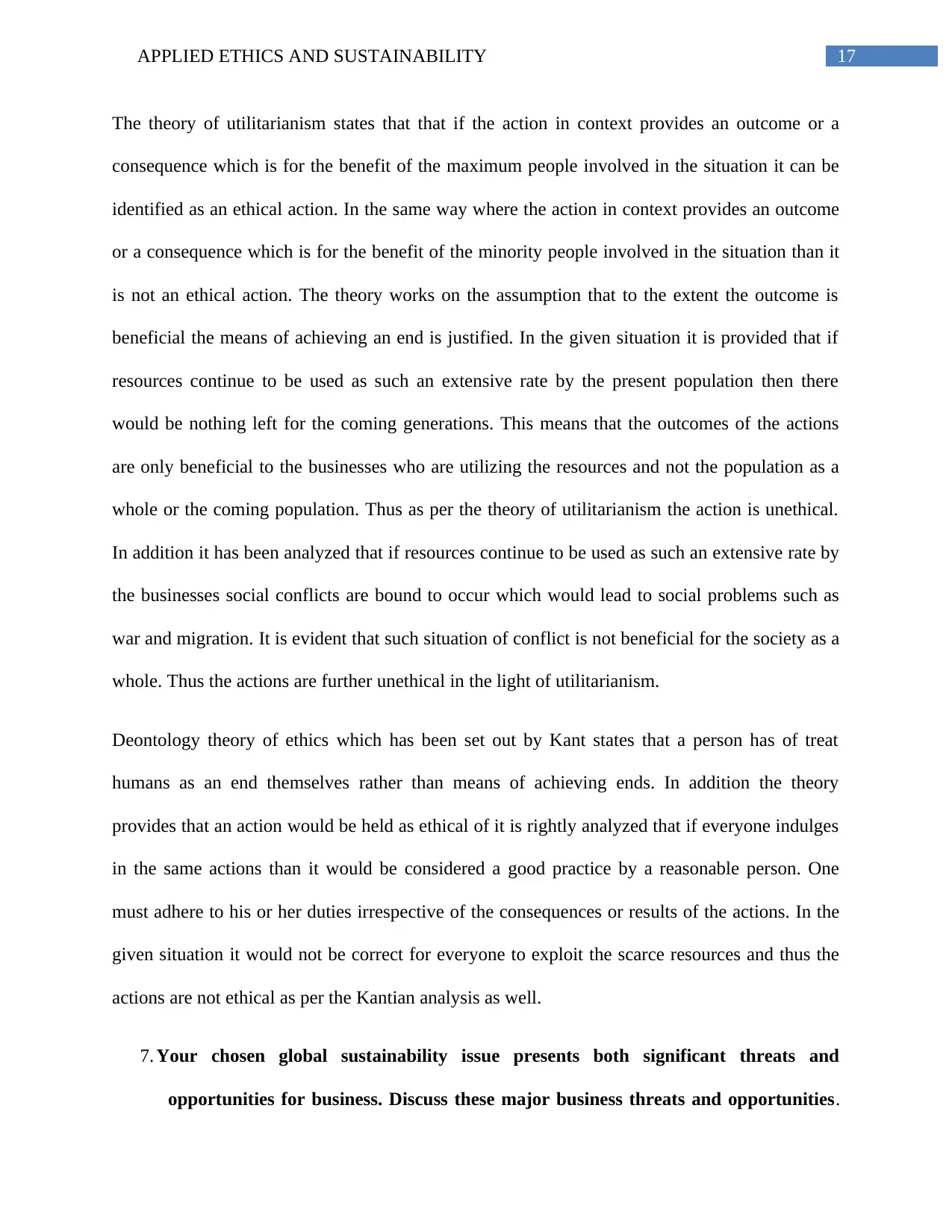
17APPLIED ETHICS AND SUSTAINABILITY
The theory of utilitarianism states that that if the action in context provides an outcome or a
consequence which is for the benefit of the maximum people involved in the situation it can be
identified as an ethical action. In the same way where the action in context provides an outcome
or a consequence which is for the benefit of the minority people involved in the situation than it
is not an ethical action. The theory works on the assumption that to the extent the outcome is
beneficial the means of achieving an end is justified. In the given situation it is provided that if
resources continue to be used as such an extensive rate by the present population then there
would be nothing left for the coming generations. This means that the outcomes of the actions
are only beneficial to the businesses who are utilizing the resources and not the population as a
whole or the coming population. Thus as per the theory of utilitarianism the action is unethical.
In addition it has been analyzed that if resources continue to be used as such an extensive rate by
the businesses social conflicts are bound to occur which would lead to social problems such as
war and migration. It is evident that such situation of conflict is not beneficial for the society as a
whole. Thus the actions are further unethical in the light of utilitarianism.
Deontology theory of ethics which has been set out by Kant states that a person has of treat
humans as an end themselves rather than means of achieving ends. In addition the theory
provides that an action would be held as ethical of it is rightly analyzed that if everyone indulges
in the same actions than it would be considered a good practice by a reasonable person. One
must adhere to his or her duties irrespective of the consequences or results of the actions. In the
given situation it would not be correct for everyone to exploit the scarce resources and thus the
actions are not ethical as per the Kantian analysis as well.
7. Your chosen global sustainability issue presents both significant threats and
opportunities for business. Discuss these major business threats and opportunities.
The theory of utilitarianism states that that if the action in context provides an outcome or a
consequence which is for the benefit of the maximum people involved in the situation it can be
identified as an ethical action. In the same way where the action in context provides an outcome
or a consequence which is for the benefit of the minority people involved in the situation than it
is not an ethical action. The theory works on the assumption that to the extent the outcome is
beneficial the means of achieving an end is justified. In the given situation it is provided that if
resources continue to be used as such an extensive rate by the present population then there
would be nothing left for the coming generations. This means that the outcomes of the actions
are only beneficial to the businesses who are utilizing the resources and not the population as a
whole or the coming population. Thus as per the theory of utilitarianism the action is unethical.
In addition it has been analyzed that if resources continue to be used as such an extensive rate by
the businesses social conflicts are bound to occur which would lead to social problems such as
war and migration. It is evident that such situation of conflict is not beneficial for the society as a
whole. Thus the actions are further unethical in the light of utilitarianism.
Deontology theory of ethics which has been set out by Kant states that a person has of treat
humans as an end themselves rather than means of achieving ends. In addition the theory
provides that an action would be held as ethical of it is rightly analyzed that if everyone indulges
in the same actions than it would be considered a good practice by a reasonable person. One
must adhere to his or her duties irrespective of the consequences or results of the actions. In the
given situation it would not be correct for everyone to exploit the scarce resources and thus the
actions are not ethical as per the Kantian analysis as well.
7. Your chosen global sustainability issue presents both significant threats and
opportunities for business. Discuss these major business threats and opportunities.
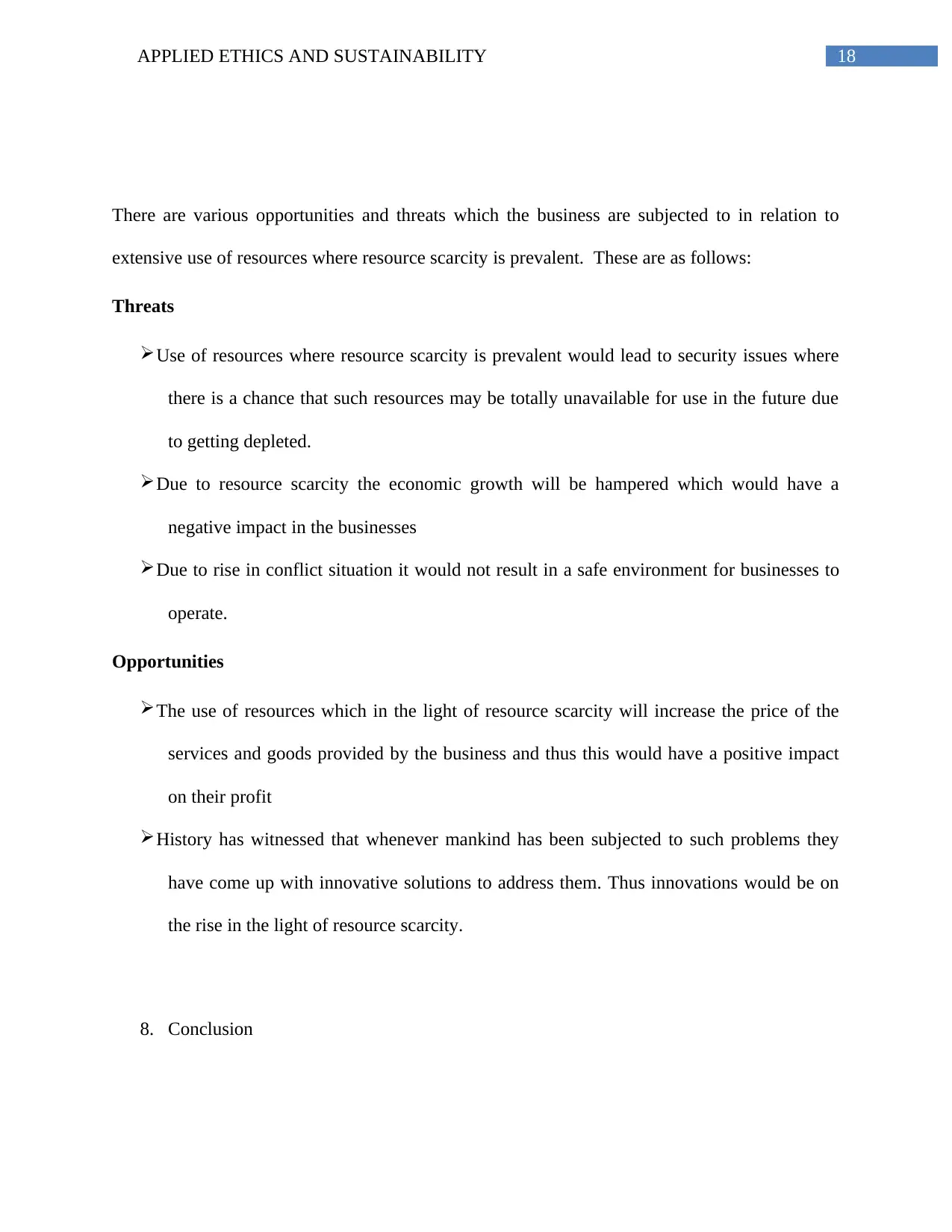
18APPLIED ETHICS AND SUSTAINABILITY
There are various opportunities and threats which the business are subjected to in relation to
extensive use of resources where resource scarcity is prevalent. These are as follows:
Threats
Use of resources where resource scarcity is prevalent would lead to security issues where
there is a chance that such resources may be totally unavailable for use in the future due
to getting depleted.
Due to resource scarcity the economic growth will be hampered which would have a
negative impact in the businesses
Due to rise in conflict situation it would not result in a safe environment for businesses to
operate.
Opportunities
The use of resources which in the light of resource scarcity will increase the price of the
services and goods provided by the business and thus this would have a positive impact
on their profit
History has witnessed that whenever mankind has been subjected to such problems they
have come up with innovative solutions to address them. Thus innovations would be on
the rise in the light of resource scarcity.
8. Conclusion
There are various opportunities and threats which the business are subjected to in relation to
extensive use of resources where resource scarcity is prevalent. These are as follows:
Threats
Use of resources where resource scarcity is prevalent would lead to security issues where
there is a chance that such resources may be totally unavailable for use in the future due
to getting depleted.
Due to resource scarcity the economic growth will be hampered which would have a
negative impact in the businesses
Due to rise in conflict situation it would not result in a safe environment for businesses to
operate.
Opportunities
The use of resources which in the light of resource scarcity will increase the price of the
services and goods provided by the business and thus this would have a positive impact
on their profit
History has witnessed that whenever mankind has been subjected to such problems they
have come up with innovative solutions to address them. Thus innovations would be on
the rise in the light of resource scarcity.
8. Conclusion
Paraphrase This Document
Need a fresh take? Get an instant paraphrase of this document with our AI Paraphraser
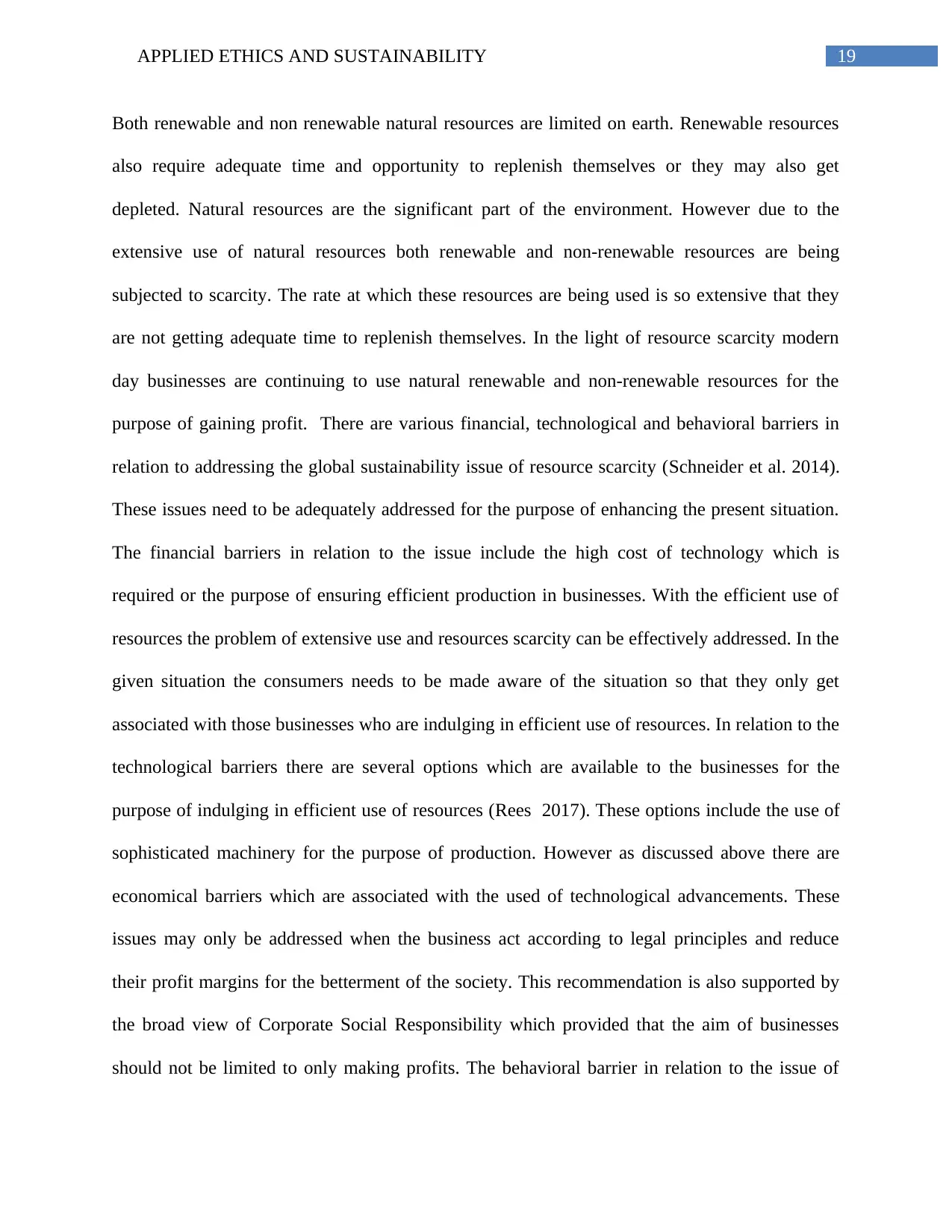
19APPLIED ETHICS AND SUSTAINABILITY
Both renewable and non renewable natural resources are limited on earth. Renewable resources
also require adequate time and opportunity to replenish themselves or they may also get
depleted. Natural resources are the significant part of the environment. However due to the
extensive use of natural resources both renewable and non-renewable resources are being
subjected to scarcity. The rate at which these resources are being used is so extensive that they
are not getting adequate time to replenish themselves. In the light of resource scarcity modern
day businesses are continuing to use natural renewable and non-renewable resources for the
purpose of gaining profit. There are various financial, technological and behavioral barriers in
relation to addressing the global sustainability issue of resource scarcity (Schneider et al. 2014).
These issues need to be adequately addressed for the purpose of enhancing the present situation.
The financial barriers in relation to the issue include the high cost of technology which is
required or the purpose of ensuring efficient production in businesses. With the efficient use of
resources the problem of extensive use and resources scarcity can be effectively addressed. In the
given situation the consumers needs to be made aware of the situation so that they only get
associated with those businesses who are indulging in efficient use of resources. In relation to the
technological barriers there are several options which are available to the businesses for the
purpose of indulging in efficient use of resources (Rees 2017). These options include the use of
sophisticated machinery for the purpose of production. However as discussed above there are
economical barriers which are associated with the used of technological advancements. These
issues may only be addressed when the business act according to legal principles and reduce
their profit margins for the betterment of the society. This recommendation is also supported by
the broad view of Corporate Social Responsibility which provided that the aim of businesses
should not be limited to only making profits. The behavioral barrier in relation to the issue of
Both renewable and non renewable natural resources are limited on earth. Renewable resources
also require adequate time and opportunity to replenish themselves or they may also get
depleted. Natural resources are the significant part of the environment. However due to the
extensive use of natural resources both renewable and non-renewable resources are being
subjected to scarcity. The rate at which these resources are being used is so extensive that they
are not getting adequate time to replenish themselves. In the light of resource scarcity modern
day businesses are continuing to use natural renewable and non-renewable resources for the
purpose of gaining profit. There are various financial, technological and behavioral barriers in
relation to addressing the global sustainability issue of resource scarcity (Schneider et al. 2014).
These issues need to be adequately addressed for the purpose of enhancing the present situation.
The financial barriers in relation to the issue include the high cost of technology which is
required or the purpose of ensuring efficient production in businesses. With the efficient use of
resources the problem of extensive use and resources scarcity can be effectively addressed. In the
given situation the consumers needs to be made aware of the situation so that they only get
associated with those businesses who are indulging in efficient use of resources. In relation to the
technological barriers there are several options which are available to the businesses for the
purpose of indulging in efficient use of resources (Rees 2017). These options include the use of
sophisticated machinery for the purpose of production. However as discussed above there are
economical barriers which are associated with the used of technological advancements. These
issues may only be addressed when the business act according to legal principles and reduce
their profit margins for the betterment of the society. This recommendation is also supported by
the broad view of Corporate Social Responsibility which provided that the aim of businesses
should not be limited to only making profits. The behavioral barrier in relation to the issue of
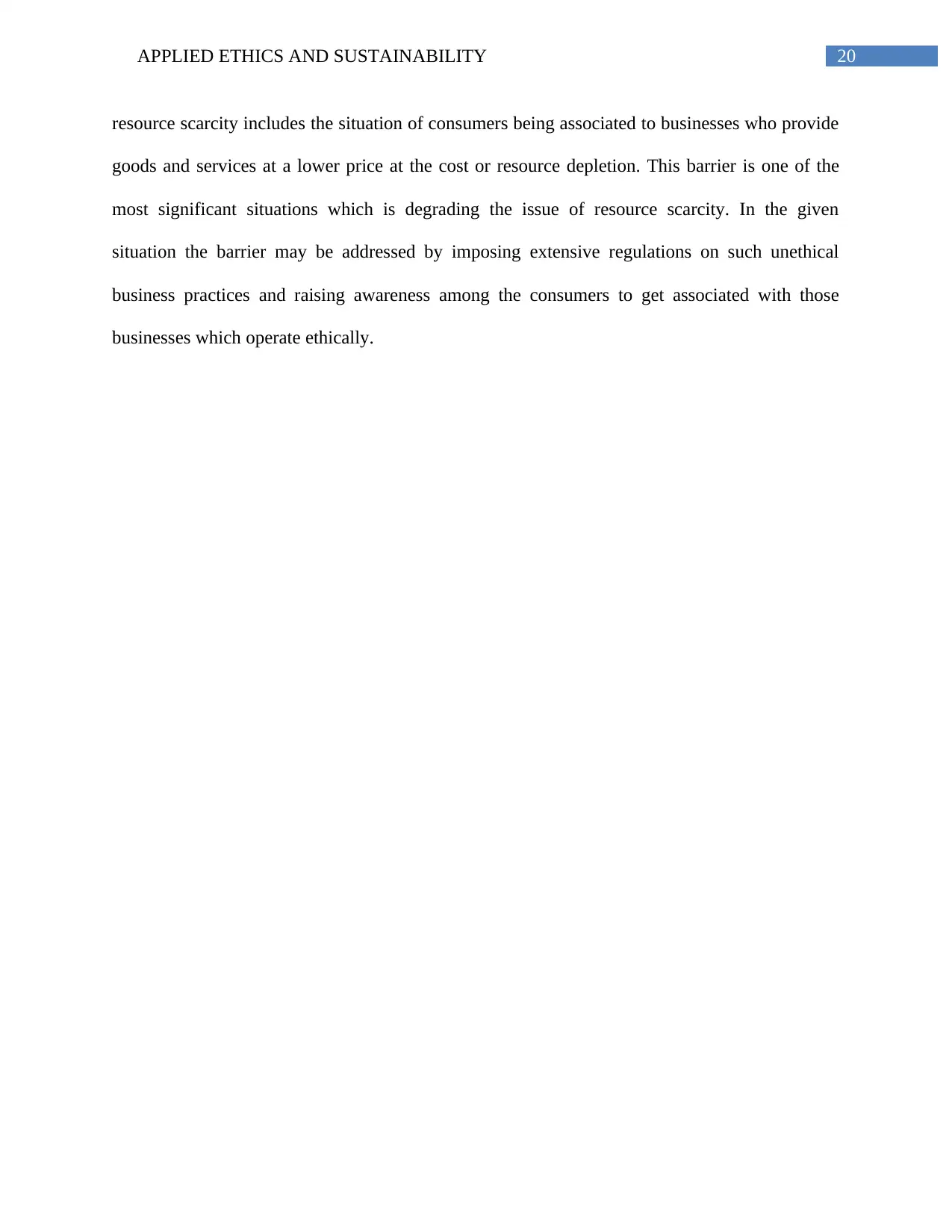
20APPLIED ETHICS AND SUSTAINABILITY
resource scarcity includes the situation of consumers being associated to businesses who provide
goods and services at a lower price at the cost or resource depletion. This barrier is one of the
most significant situations which is degrading the issue of resource scarcity. In the given
situation the barrier may be addressed by imposing extensive regulations on such unethical
business practices and raising awareness among the consumers to get associated with those
businesses which operate ethically.
resource scarcity includes the situation of consumers being associated to businesses who provide
goods and services at a lower price at the cost or resource depletion. This barrier is one of the
most significant situations which is degrading the issue of resource scarcity. In the given
situation the barrier may be addressed by imposing extensive regulations on such unethical
business practices and raising awareness among the consumers to get associated with those
businesses which operate ethically.
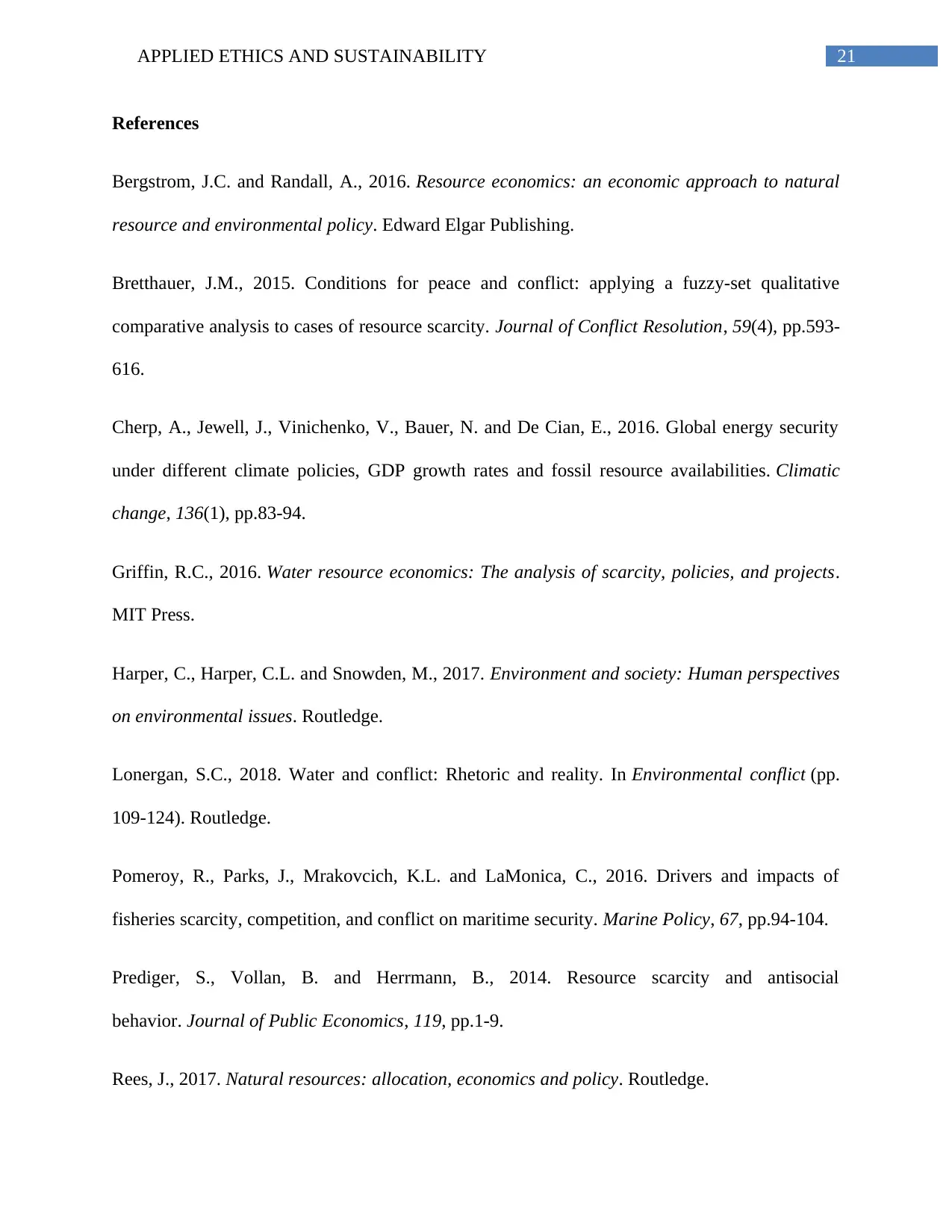
21APPLIED ETHICS AND SUSTAINABILITY
References
Bergstrom, J.C. and Randall, A., 2016. Resource economics: an economic approach to natural
resource and environmental policy. Edward Elgar Publishing.
Bretthauer, J.M., 2015. Conditions for peace and conflict: applying a fuzzy-set qualitative
comparative analysis to cases of resource scarcity. Journal of Conflict Resolution, 59(4), pp.593-
616.
Cherp, A., Jewell, J., Vinichenko, V., Bauer, N. and De Cian, E., 2016. Global energy security
under different climate policies, GDP growth rates and fossil resource availabilities. Climatic
change, 136(1), pp.83-94.
Griffin, R.C., 2016. Water resource economics: The analysis of scarcity, policies, and projects.
MIT Press.
Harper, C., Harper, C.L. and Snowden, M., 2017. Environment and society: Human perspectives
on environmental issues. Routledge.
Lonergan, S.C., 2018. Water and conflict: Rhetoric and reality. In Environmental conflict (pp.
109-124). Routledge.
Pomeroy, R., Parks, J., Mrakovcich, K.L. and LaMonica, C., 2016. Drivers and impacts of
fisheries scarcity, competition, and conflict on maritime security. Marine Policy, 67, pp.94-104.
Prediger, S., Vollan, B. and Herrmann, B., 2014. Resource scarcity and antisocial
behavior. Journal of Public Economics, 119, pp.1-9.
Rees, J., 2017. Natural resources: allocation, economics and policy. Routledge.
References
Bergstrom, J.C. and Randall, A., 2016. Resource economics: an economic approach to natural
resource and environmental policy. Edward Elgar Publishing.
Bretthauer, J.M., 2015. Conditions for peace and conflict: applying a fuzzy-set qualitative
comparative analysis to cases of resource scarcity. Journal of Conflict Resolution, 59(4), pp.593-
616.
Cherp, A., Jewell, J., Vinichenko, V., Bauer, N. and De Cian, E., 2016. Global energy security
under different climate policies, GDP growth rates and fossil resource availabilities. Climatic
change, 136(1), pp.83-94.
Griffin, R.C., 2016. Water resource economics: The analysis of scarcity, policies, and projects.
MIT Press.
Harper, C., Harper, C.L. and Snowden, M., 2017. Environment and society: Human perspectives
on environmental issues. Routledge.
Lonergan, S.C., 2018. Water and conflict: Rhetoric and reality. In Environmental conflict (pp.
109-124). Routledge.
Pomeroy, R., Parks, J., Mrakovcich, K.L. and LaMonica, C., 2016. Drivers and impacts of
fisheries scarcity, competition, and conflict on maritime security. Marine Policy, 67, pp.94-104.
Prediger, S., Vollan, B. and Herrmann, B., 2014. Resource scarcity and antisocial
behavior. Journal of Public Economics, 119, pp.1-9.
Rees, J., 2017. Natural resources: allocation, economics and policy. Routledge.
Secure Best Marks with AI Grader
Need help grading? Try our AI Grader for instant feedback on your assignments.
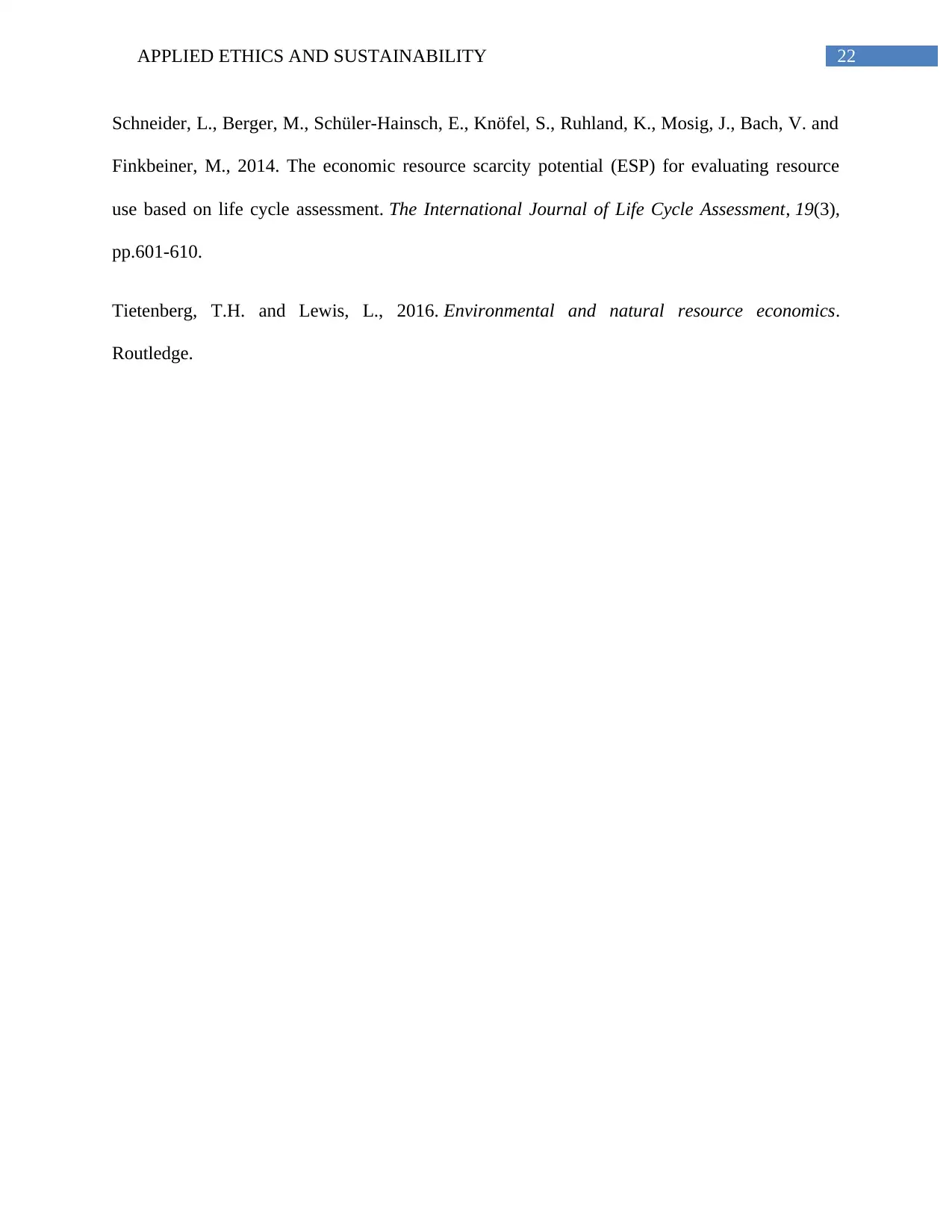
22APPLIED ETHICS AND SUSTAINABILITY
Schneider, L., Berger, M., Schüler-Hainsch, E., Knöfel, S., Ruhland, K., Mosig, J., Bach, V. and
Finkbeiner, M., 2014. The economic resource scarcity potential (ESP) for evaluating resource
use based on life cycle assessment. The International Journal of Life Cycle Assessment, 19(3),
pp.601-610.
Tietenberg, T.H. and Lewis, L., 2016. Environmental and natural resource economics.
Routledge.
Schneider, L., Berger, M., Schüler-Hainsch, E., Knöfel, S., Ruhland, K., Mosig, J., Bach, V. and
Finkbeiner, M., 2014. The economic resource scarcity potential (ESP) for evaluating resource
use based on life cycle assessment. The International Journal of Life Cycle Assessment, 19(3),
pp.601-610.
Tietenberg, T.H. and Lewis, L., 2016. Environmental and natural resource economics.
Routledge.
1 out of 23
Related Documents
Your All-in-One AI-Powered Toolkit for Academic Success.
+13062052269
info@desklib.com
Available 24*7 on WhatsApp / Email
![[object Object]](/_next/static/media/star-bottom.7253800d.svg)
Unlock your academic potential
© 2024 | Zucol Services PVT LTD | All rights reserved.




